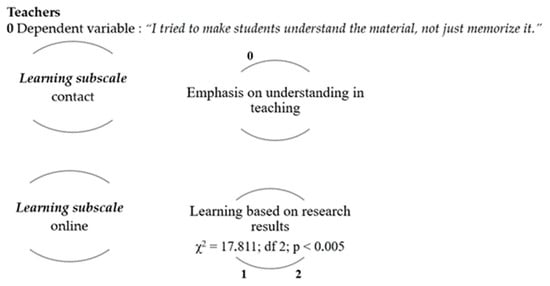Abstract
This study investigates the effectiveness of contact and online biology teaching by assessing student performance and gathering perceptions from students, teachers, and parents. Conducted in autumn 2021 with 3035 students, 124 biology teachers, and 719 parents, this study combined post-instruction assessments of student performance in knowledge reproduction and conceptual understanding with questionnaires examining perceptions of contact and online biology teaching effectiveness across students, teachers, and parents. To investigate how various teaching-related factors influence perceived understanding of biological content, we applied a CHAID-based decision tree model to questionnaire responses from students, teachers, and parents. Results indicated that students value engaging, flexible instruction, sufficient time to complete tasks and support for independent thinking. Teachers emphasized their satisfaction with teaching and efforts to support student understanding. In contact lessons, students preferred problem-solving, teacher guidance, and a stimulating environment. In online learning, they preferred low-stress, interesting lessons with room for independent work. Parents emphasized satisfaction with their child’s learning and the importance of a focused, stimulating environment. This comparative analysis highlights the need for student-centered, research-based biology teaching in both formats, supported by teachers and delivered in a motivating environment. The results offer practical insights for improving biology instruction in different teaching modalities.
1. Introduction
The rise of digital technologies and the recent global shift toward distance education—intensified by the COVID-19 pandemic—have led to a global reassessment of the effectiveness of teaching modalities that require deep conceptual understanding, such as biology (Anwar et al., 2022; Bartková et al., 2024; Bulić, 2018; Dhawan, 2020; Kolawole & Kehinde, 2022). Both contact (face-to-face) and online teaching offer different advantages and limitations—while online teaching allows flexibility and access to various resources, face-to-face teaching offers immediate feedback, richer interpersonal interactions and a more controlled learning environment (Bulić, 2018; Dhawan, 2020; Nuangchalerm et al., 2021). These differences are particularly significant in terms of student engagement in higher-order cognitive tasks—such as conceptual problem solving and knowledge integration—that support deep learning in biology.
Deep learning requires students not only to reproduce factual knowledge but to actively connect new concepts to prior knowledge, apply them to novel situations, and understand their relevance in real-world systems (Tanner & Allen, 2005). There is strong consensus in biology education research that fostering systems thinking—the ability to understand the interconnected nature of biological processes—is essential for developing scientific literacy (Long et al., 2024). Effective teaching involves activating students’ prior knowledge, engaging them in purposeful activities that increase their attention, using learning organizers that emphasize the relevance of the content and regularly checking students’ understanding (Yoon et al., 2023). Linking teaching and learning activities in the classroom with practical life experiences and the learning environment is also important (Karamane et al., 2023). Therefore, biology teachers should not only have good subject knowledge and a passion for teaching, but also pedagogical knowledge to motivate and engage students in learning (Burić & Kim, 2020; Chapooa et al., 2018).
Understanding the relationship between teaching modality and learning outcomes is incomplete without considering the perspectives of all key stakeholders: students, teachers, and parents (Fitzgerald et al., 2020; Karamane et al., 2023; Mapulanga & Bwalya, 2024). Their views shape classroom dynamics, instructional design, and student engagement (Kolawole & Kehinde, 2022; Sindhuangelin & Jesintha Mary, 2022; Uludağ & Erkan, 2023)—factors that directly influence how well biological content is understood and applied.
This study investigates the impact of teaching modality on both perceived and actual learning outcomes in biology. Specifically, it compares contact (C) and online (O) biology teaching from the perspectives of students, teachers, and parents, and evaluates how each setting supports students’ conceptual understanding and factual knowledge. The study objectives were to: (O1) assess student performance on knowledge reproduction and conceptual understanding tasks in contact and online biology teaching, based on post-instruction assessments; (O2) examine perceptions of teaching, learning, and student understanding during online biology instruction from the perspectives of students, teachers, and parents; (O3) identify factors contributing to student understanding of biology content in both contact and online instruction as perceived by students, teachers, and parents. The linked study hypotheses were that: (H1) student performance on post-instruction assessments is lower following intensive online teaching compared to contact teaching, with significantly weaker outcomes observed for conceptual understanding tasks than for knowledge reproduction tasks; (H2) significant differences exist in perceived teaching effectiveness among students, teachers, and parents, with teachers showing the most positive perceptions; (H3a) in contact teaching, student understanding is positively associated with strong teacher guidance and engagement in diverse learning activities; (H3b) in online teaching, student understanding is positively associated with structured instruction and students’ ability to self-regulate and maintain concentration; (H3c) across both teaching modes, student understanding is enhanced by a positive classroom climate, teacher adaptability, and motivation strategies that promote inquiry-based learning.
By combining empirical retention assessments with triangulated feedback from students, teachers, and parents, this study contributes valuable evidence to ongoing debates in science education by illuminating how both contact and online teaching modalities support or hinder deeper conceptual understanding and knowledge retention.
2. Theoretical Framework
This section outlines the theoretical and conceptual foundations of the study. It introduces key learning theories and examines relevant research on teaching modalities (contact vs. online) and stakeholder (i.e., students’, teachers’, and parents’) perceptions, providing context for the study’s focus on biology education across different formats.
The study is grounded in constructivist learning theory, which views learning as an active process shaped by interaction with content, teachers, peers, and the learning environment. Within this framework, student understanding is observable through cognitive engagement and performance on tasks requiring conceptual reasoning (Bransford et al., 2000). The study also draws on pedagogical content knowledge (PCK) theory (Shulman, 1986), which highlights the importance of teachers’ ability to transform disciplinary knowledge into accessible learning experiences—particularly when teaching in varying modalities such as online and face-to-face settings.
2.1. Teaching Modalities: Contact vs. Online Teaching
In general, research shows that the benefits of contact teaching are social interaction, which is crucial for the development of social skills and a sense of belonging, immediate feedback, faster and more effective response to students’ needs, easier maintenance of students’ concentration, and motivation in a structured school environment. It is essential for subjects that require laboratory exercises, practical work, or interaction (e.g., vocational schools, physical education, and health education). In a contact environment, students and teachers are generally less stressed. On the other hand, the benefits of online teaching have been shown to include flexibility, the ability to learn at one’s own pace and from any location, the availability of materials, the development of digital skills of students and teachers, and the saving of time and resources (Moore et al., 2011). Whilst online environments enabled continuity of teaching and promoted the development of digital skills, they also showed differences in student engagement, teacher preparedness, and parental involvement.
Research suggests that hybrid models, which combine the benefits of both contact and online teaching, may offer the most promise for biology education (Moore et al., 2011). Such models can provide flexibility while maintaining opportunities for interaction, experimentation, and feedback—critical components of deep learning. However, their success depends on thoughtful instructional design, skilled facilitation, and collaboration among teachers, students, and parents (Malik & Tyagi, 2020).
2.2. Stakeholder Perceptions: Students, Teachers and Parents
Teachers’ and students’ perceptions of the teaching process have a significant impact on the effectiveness of teaching and learning (Mapulanga & Bwalya, 2024). Comparing these perceptions can provide valuable insights into teaching practices and behaviors (Karamane et al., 2023). In particular, discrepancies between teachers’ and students’ views may affect teachers’ ability to align their behavior with students’ needs in the classroom (Fitzgerald et al., 2020).
Students’ opinions on the effectiveness of online teaching are divided. As advantages, they cite flexibility and independence in learning, better concentration due to fewer distracting factors, ease to following lessons and learning at their own pace, flexibility in organizing their own schedule and saving time, constant access to materials, and a more pleasant environment (Almahasees et al., 2021). As disadvantages, they mention the overload of tasks; the large number of tasks to be completed in a short time and the need to make considerable effort; difficulties in understanding the material, emphasizing that the quality of teaching is poorer than in contact teaching, which makes it difficult for them to master the material; the lack of direct interaction with teachers and peers affecting the quality of learning and motivation; technical difficulties; health problems, such as headaches and musculoskeletal disorders, due to prolonged sitting in front of a screen; and lower academic control that can affect their success (Almahasees et al., 2021; Beganović, 2021; Neralić, 2023; Ristić Dedić, 2020; Ristić Dedić & Jokić, 2021). Studies on student satisfaction with online teaching have shown a medium level of satisfaction, which indicates that students are neither extremely satisfied nor extremely dissatisfied (Ristić Dedić, 2020).
It is not only in the context of the experiences with the COVID-19 pandemic that teachers are confronted with the need to adapt to new teaching methods and lesson organization when teaching online. As advantages of online teaching, teachers highlight the opportunity to improve their own digital skills and use new technological tools in the classroom, the flexibility in scheduling, and the individualized approach, as online tools make it easier to monitor the progress of individual students and adapt materials (Dhawan, 2020; Mishra et al., 2020). On the other hand, teachers cited overload in customizing materials, preparing online content, and assessing student work; a lack of feedback, as it is more difficult to obtain immediate feedback on students’ understanding of the material in an online environment; technical challenges, a lack of appropriate equipment or knowledge on how to use platforms; and difficulty interacting and maintaining discipline and motivation as disadvantages (Almahasees et al., 2021; Dhawan, 2020).
Parents have become important participants in their children’s education in online courses and often take on a supportive and sometimes teaching role. According to parents, the benefits of online classes include less traveling, better insight into the child’s work, i.e., the ability to monitor the child’s progress and better understand the teaching process, learning together, and developing their digital skills (Garbe et al., 2020; Radanović et al., 2022). However, parents also often feel overwhelmed because the burden of teaching the children is partly on them, which can be challenging, especially for those who do not have the necessary knowledge and skills. Parents also cited technical difficulties in balancing their own work and home responsibilities with helping their children to learn (Garbe et al., 2020; Radanović et al., 2022). Other disadvantages cited by parents were that teachers do not check all tasks and do not provide enough feedback, that the quality of teaching is poorer, and that learning success is lower. Parents’ satisfaction with online lessons also varied. Around half of the parents expressed satisfaction, while a significant proportion were dissatisfied or neutral (Garbe et al., 2020; Raboteg, 2023; Radanović et al., 2022).
3. Materials and Methods
3.1. Study Context
This study was conducted in Croatia, where, like in many countries worldwide, the outbreak of the COVID-19 pandemic prompted an abrupt and large-scale shift from traditional classroom teaching to online instruction. On 16 March 2020, all Croatian schools transitioned to distance learning, following directives from the Croatian Ministry of Science and Education (MZO, 2020). In the initial phase, educational content was delivered via national television and online platforms. Within just a few weeks, more than 3000 video lessons had been created by teachers for all subjects and grade levels. These resources remained freely available and publicly accessible throughout the school year.
The academic year 2020/2021 was marked by the introduction of a hybrid teaching model, in which instruction alternated between online and contact classes based on regional health risks and infection rates. Students in primary schools (ages 7–14) and secondary schools (ages 15–18) experienced different degrees of exposure to each modality. While younger students gradually returned to classroom settings by mid-May 2020, older students—particularly those in upper primary and secondary education—continued with a combination of online and contact learning until the end of the school year (MZO, 2020).
The research presented in this paper was carried out in this educational context, focusing specifically on biology teaching in primary and secondary schools. It investigates differences in student learning outcomes and perceived teaching effectiveness during this period of educational disruption and modality shifts. The perceptions of students, teachers, and parents reflect their direct experiences with online and hybrid learning models implemented during the 2020/2021 academic year, particularly during periods of partial or full educational lockdowns.
3.2. Respondents
This study was conducted in the autumn of 2021 and included responses from 3035 students, 124 biology teachers, and 719 parents. It consisted of two complementary parts.
The first part of the study focused on evaluating actual student performance in biology through post-instruction assessments that measured both knowledge reproduction and conceptual understanding. These retention tests were completed by 3035 students, ranging from 2nd grade primary school students (approximately 8 years old) to 4th grade secondary school students (approximately 18 years old). Importantly, a specific subsample of first-year university students (aged around 19) was included in this part of the study because they had completed the 4th grade of secondary school during the 2020/2021 academic year, the period when intensive online or hybrid teaching was implemented due to the COVID-19 pandemic. At the time of data collection, these students had already entered university, making them suitable for retrospective evaluation of learning retention from their final year of secondary education. The tests were developed and calibrated on a pilot sample of approximately 50 students and subsequently refined for broader application in this study. This breadth provided a comprehensive view of biology teaching across the Croatian education system.
The second part focused on assessing the perceived effectiveness of contact and online biology teaching, based on questionnaire responses from three groups of participants: students, biology teachers, and parents. Out of the total student sample, 1257 students also participated in this perception-based study. Data were collected online using the LimeSurvey platform. To ensure alignment between perspectives, all students in the sample were taught by one of the teachers who completed the teacher questionnaire, and each parent respondent had at least one child who completed the student questionnaire and was taught by a participating teacher. This interconnected sampling design allowed for a meaningful comparison of perceived teaching and learning experiences within the same educational triads—students, their teachers, and their parents.
This dual approach—perceptual and performance-based—enabled a comprehensive analysis of both how teaching was experienced and how it translated into learning outcomes, within the contrasting settings of contact and online biology instruction. Participation was voluntary, anonymous, and based on informed consent. Teachers volunteered to join the study at the national level, with the approval of school principals. Parental consent was obtained for all student participants, and many parents also chose to complete the questionnaire themselves. The sample included respondents from all geographic regions of Croatia, providing a diverse national overview of experiences with biology teaching in both contact and online learning contexts. Respondents were informed that they could withdraw from the study at any point without consequence. All procedures were conducted in accordance with ethical research standards for educational studies.
3.3. Post-Instruction Assessment of Student Performance in Biology
To gain insight into students’ achieved understanding as an external indicator of academic performance and a quantitative measure of learning, online knowledge tests were analyzed. These assessments were conducted via the MoD platform (Moodle LMS) in collaboration with the University Computing Center (SRCE). Following the period of intensive online/hybrid teaching due to the COVID-19 pandemic, a total of 3035 students were tested in the autumn of 2021 to evaluate their retention of biology content taught during the previous school year.
Testing was carried out across the vertical continuum of biological education, with two biological concepts assessed in each grade: Energy effects of nutrition in living organisms and Adaptations of organisms as consequences of evolution. Content was aligned with the national curriculum and enriched through field-based learning experiences.
For the purposes of this study, analysis focused on the solvability of closed-ended test items, which included multiple-choice and structured response formats. To assess students’ understanding, test items were categorized into two cognitive levels: reproduction tasks (targeting recall and factual knowledge) and higher-order tasks (requiring application, conceptual understanding or problem-solving skills). Analysis of variance (ANOVA) was conducted within the student sample to determine differences in performance between tasks requiring reproductive knowledge and those demanding higher-level cognitive processing.
3.4. Assessing Perceived Effectiveness of Contact and Online Biology Teaching via Questionnaire
To assess perceptions of teaching quality and learning experiences, a previously validated Teaching Quality Scale (Burić & Kim, 2020) was adapted for both student and teacher questionnaires. In addition, new items were developed specifically for this study to capture the perceptions of students, teachers and parents related to both contact and online biology teaching (see Table A1, Table A2 and Table A3 in the Appendix A).
The student and teacher questionnaires were paired—both groups rated an identical set of statements comparing contact and online teaching. This allowed for the direct comparison of their perceptions regarding the same instructional practices. Parents, however, responded only to statements about online teaching, as they had a more direct insight into this mode of instruction due to their involvement in supporting their children’s learning during online schooling. Parents often observed or assisted with lessons and assignments, which gave them a practical understanding of both teaching quality and learning outcomes in the online context.
In cases where questionnaire items were phrased negatively, reverse coding was applied during data processing to ensure that all responses aligned in direction for comparative analysis. This enabled consistent interpretation of higher scores across all statements and respondent groups.
To collect opinions effectively from a diverse participant pool, Likert-type scales were used across all questionnaires, though the number of response options varied by respondent group to ensure clarity and accessibility. For younger students, a three-point measurement scale was used, ranging from “completely agree” to “completely disagree”, intentionally omitting a neutral option to simplify decision-making and facilitate participation for children as young as eight years old (see Section 3.4.1 for a detailed explanation of the student questionnaire). For teachers, a standard five-point Likert scale was used, allowing a more nuanced expression of agreement or disagreement (see Section 3.4.2 for a detailed explanation of the teachers’ questionnaire). For parents, a six-point Likert scale was employed. This extended the standard five-point format used with teachers by adding a sixth option “cannot assess”, to account for varying levels of parental involvement and awareness of their child’s schooling during the online learning period (see Section 3.4.3 for a detailed explanation of the parents’ questionnaire).
Although different scale lengths were applied across groups, this did not affect the validity of the comparisons, as responses from each group were analyzed separately. This approach preserved the internal consistency of each dataset while respecting the developmental and situational differences between students, teachers, and parents. Finally, all questionnaire items were grouped into three thematic clusters (referred to as subscales in the rest of the article, i.e., Teaching subscale, Learning subscale, Teacher subscale, Students subscale) to allow meaningful comparison across participant groups. This structure supported the study’s aim of triangulating perceptions across students, teachers, and parents within the context of both contact and online biology teaching. To ensure that the items within each thematic area (subscale) reliably measured the intended constructs, the internal consistency of the scales was assessed using Cronbach’s alpha (α), a standard measure of scale reliability.
3.4.1. Students’ Questionnaire
Students completed a questionnaire consisting of 56 statements comparing contact and online teaching. A three-point measurement scale was used for assessment, as the sample included students aged 8 to 12 who attended the subjects Science and Society and Science, which cover biological content. The scale was adapted for this age group, with the following values: 1—strongly disagree, 2—somewhat agree, 3—fully agree. Although this format differs from a traditional Likert scale, it was intentionally chosen to suit the developmental level of the students and to ensure ease of understanding and response. The questionnaire items (Table A1) were divided into three subscales. The Teacher subscale (Table A1/Figure A1) included 15 items related to teaching quality (S1–S15). The Teaching subscale (Table A1/Figure A2) included 27 items (S16–S42). The Learning subscale (Table A1/Figure A3) contained 14 items (S43–S56). Teacher subscale showed high internal consistency, with a Cronbach’s alpha (Table 1) indicating excellent reliability for interpretation. The Teaching and Learning subscales also showed good reliability, based on their Cronbach’s alpha values (Table 1).

Table 1.
Reliability of measurement instruments for survey subscales according to Cronbach’s alpha (α).
3.4.2. Teachers’ Questionnaire
Teachers completed a questionnaire (Table A2) containing 46 statements, evaluated using a five-point Likert scale (1—strongly disagree, 2—somewhat disagree, 3—neither agree nor disagree, 4—somewhat agree, 5—strongly agree). The items were organized into three subscales: Teaching (Table A2/Figure A4), comprising 23 items (T1–T23); Learning (Table A2/Figure A5), with 15 items (T24–T38); and Students (Table A2/Figure A6), containing 8 items (T39–T46). Teacher responses demonstrated high internal consistency in the Students subscale and in the Teaching subscale for the online teaching context (Table 1). Good reliability was also observed in the Teaching subscale for contact teaching and in the Learning subscale for online teaching. The lowest consistency was found in the Learning subscale during contact teaching; however, even this result falls within an acceptable range of reliability (Table 1).
3.4.3. Parents’ Questionnaire
The parent questionnaire on online biology teaching (Table A3) consisted of 34 statements, evaluated using a six-point Likert scale (1—strongly disagree, 2—somewhat disagree, 3—neither agree nor disagree, 4—somewhat agree, 5—strongly agree, 6—cannot assess). The option “cannot assess” was included to ensure greater response accuracy and to provide insight into the level of parental involvement in their child’s learning. The parent questionnaire items were divided into three subscales (Table A3/Figure A7): Teacher with 7 items (P1–P7); Teaching with 16 items (P8–P23); and Learning with 11 items (P24–P34). Parent responses showed good internal consistency in the Teaching subscale, while the Teacher and Learning subscales demonstrated acceptable reliability (Table 1).
3.4.4. Modeling Predictors of Student Understanding Using CHAID Decision Trees
To investigate the differences in the perceived effectiveness of contact and online teaching on student understanding of biological content, we analyzed responses regarding how well students felt they understood the material—a key objective of biology education at the primary and secondary levels (MZO, 2019a, 2019b, 2019c). For this purpose, we used a decision tree classification model based on the CHAID (Chi-Square Automatic Interaction Detector) technique. Conceptually, a decision tree is a hierarchical model consisting of a set of rules that divide a heterogeneous set of input data into groups homogeneous with respect to the categories of the dependent variables (Milanović & Stamenković, 2016). CHAID is a statistical method used to identify relationships between a categorical dependent variable and multiple independent variables by performing Chi-square (χ2) tests of association. It is particularly effective for detecting patterns in categorical data and understanding how different factors influence a target outcome. CHAID decision tree analysis was chosen to model students’ understanding of biological content, as it offers a clear, visual representation of decision rules derived from participant responses.
A decision tree consists of hierarchically organized nodes connected by branches. The “root node” represents the dependent variable and includes all data, which is split into classes during model development (Milanović & Stamenković, 2016). Unlike the root, all other nodes have one input branch and multiple output branches, representing conditions tested for each variable (Rokach & Maimon, 2015). “Internal (decision) nodes” test these conditions, while “terminal nodes” represent solutions. In this study, the dependent variable in this study was participants’ self-reported understanding of biological content. Predictor variables included items from three questionnaire subscales: perceptions of the Teacher/Student in the class, perception of Teaching practices, and perceptions of Learning. Additional variables included teaching format (contact vs. online) and respondent role (student, teacher or parent), allowing for the exploration of differing perspectives among key stakeholders in the teaching process. Terminal nodes in this study play a decisive role in shaping how a particular group of respondents understands the biological content. To enable comparisons, the negative responses from the questionnaire were recoded into a positive format, allowing them to be compared with the other participants’ responses (e.g., S21–S24, S31, S32, P13, P14, P22, and P23) (Table A1 and Table A3).
The CHAID model was configured with an alpha level of 0.05 for both splitting and merging criteria, and a Bonferroni correction was applied to control for multiple comparisons. To maintain clarity and interpretability of the resulting classification tree, the maximum tree depth was set to three levels. The Chi-square (χ2) values reported in the CHAID analysis indicate the statistical strength of the association between the dependent variable and each predictor at a given split in the tree—higher χ2 values reflect stronger relationships and greater contribution of that variable to explaining differences in perceived understanding of biological content. Associated p-values indicate whether these relationships are statistically significant; p-values less than 0.05 suggest that the observed differences are unlikely to have occurred by chance and that the predictor variable significantly contributes to the split at that point in the tree. The CHAID model revealed statistically significant differences in perceived understanding, linked to specific items within the questionnaire subscales.
The results of the decision tree are visualized in a simplified manner using the scheme shown in Figure 1. For each respondent participants group (students, teachers, and parents), the results are presented as a decision tree related to the corresponding subscale (Teaching, Learning, Teacher, Students) and implementation of learning (contact and online). The branches of the decision tree are marked with numbers, with further details in Appendix B Tables (Table A4, Table A5, Table A6, Table A7, Table A8, Table A9, Table A10, Table A11, Table A12, Table A13, Table A14, Table A15, Table A16, Table A17 and Table A18). Each branch indicates the proportion of responses according to the response (i.e., Likert) scale, aligning with the classified responses in the decision tree. During interpretation, the root node (as the most important influence on students’ understanding), internal nodes, and terminal nodes (as influence on students’ understanding) of each decision tree are highlighted. For each influence considered, the corresponding share of respondents is listed alongside the relevant branch, which, as shown in Appendix B Tables, are linked to the highlighted influence.
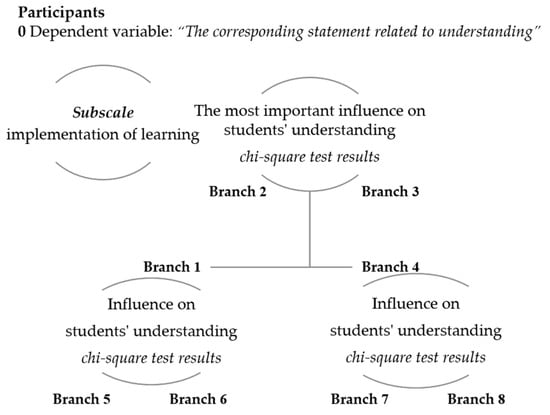
Figure 1.
Schematic guide for interpreting the CHAID decision-tree results.
4. Results
To provide a comprehensive foundation for interpreting students’ understanding of biological content, the results section is organized into two complementary parts. First, we present findings from the post-instruction assessment of student performance, based on online knowledge tests conducted in biology. These results offer insight into students’ retained knowledge from both contact and online teaching environments.
Second, we report on the perceived effectiveness of contact and online biology teaching, based on questionnaire responses from students, teachers, and parents.
4.1. Post-Instruction Assessment of Student Performance in Biology
To connect students’, teachers’, and parents’ perceptions of biology teaching with the quantitative assessment of biology learning, student performance on closed-format knowledge tests conducted online was analyzed. These tests focused on biology content knowledge and were used to assess students’ level of understanding. For this purpose, test items were categorized according to cognitive demand, distinguishing between reproduction tasks and higher-order cognitive tasks that required conceptual understanding and knowledge application.
The retention tests were completed by students, of whom approximately one-third also participated in the questionnaire on the perceived effectiveness of contact and online biology teaching. The results are presented in Table 2. The overall average success rate on the online biology knowledge tests was 48%. The best-performing group was the 8th-grade test cohort, completed by students in the first year of secondary school, while the lowest performance (32%) was observed in the 4th-grade primary school test (taken by 5th-grade students) and in the 4th-grade secondary school test (completed by first-year university students).

Table 2.
Results of biology content knowledge testing based on student performance on reproduction and conceptual understanding tasks across grade levels (N = 3035). All ANOVA p-values for within-student comparisons between cognitive task levels yielded p < 0.001 (significant values are marked with an asterisk (*) and bolded in the rightmost column).
The number of students included in the retention assessment was smaller for the lower primary school grades (1st to 4th grade) and for the final year of secondary school. Overall, 21% of students either did not complete the test or left items unanswered. The lowest dropout rates were found among primary school students (1st to 4th grade, 7–8%) and first-year secondary school students (1%), while the highest dropout rate was recorded among university students (71%), who were retrospectively assessed for their knowledge from the final year of high school.
Students demonstrated significantly higher success on reproduction tasks (63%) than on tasks requiring conceptual understanding, application or problem-solving (27%). Reproduction tasks were generally solved more successfully by primary school students than by secondary school students. In terms of conceptual understanding, results varied widely—from just 10% in the 3rd year of secondary school (covering complex content such as human and plant physiology and cellular processes) to 54% in the 1st year of primary school, where students were tested on simple, everyday knowledge with clear real-life applications.
The data suggest that students tend to show higher levels of understanding at the beginning of each educational stage, particularly at the transition from primary to secondary school. The internal consistency of the knowledge assessments was generally low (Cronbach’s alpha, α = 0.5) (Table 2), which reflects the students’ lower success rates on the higher-order cognitive tasks that test true conceptual understanding. Results from the ANOVA (within-subjects comparison of task types) revealed statistically significant differences (p < 0.001) between student performance on reproduction versus conceptual understanding tasks (Table 2).
4.2. Perceived Effectiveness of Contact and Online Biology Teaching: Questionnaire Results
Student responses (Figure A1, Figure A2 and Figure A3) showed a predominantly positive opinion about teaching and learning biology, with 96% of students showing more than 50% agreement with the statements in all three subscales (Teacher, Learning, Teaching) in relation to the teaching and learning biology. Similarly, teachers were also positive about biology instruction (Figure A4, Figure A5 and Figure A6), with more than 50% of responses indicating agreement with 78% of teacher statements within the Teaching, Learning and Students subscales. Parent responses (Figure A7) were more balanced, reflecting both positive and negative opinions of biology teaching and learning. For 65% of statements, more than 50% of parents agreed, while for 59% of statements, more than 10% of parents disagreed.
In the Students subscale of the teachers’ questionnaire, there were the greatest differences between contact and online teaching in terms of the percentage of complete agreement with the statements in the questionnaire (C = 30%; O = 13%), with a significant decrease in online teaching. Large differences between contact and online teaching in terms of the percentage of complete agreement with the questionnaire statements was observed in the Teaching subscale for both students (C = 60%, O = 53%) and teachers (C = 81%, O = 70%) (Figure 2). Conversely, the smallest differences were found in the Teacher (C = 24%, O = 26%) and Learning (C = 25%, O = 30%) subscales in the student questionnaires. For parents, the largest discrepancy in complete agreement was found in the Learning subscale (62%), while the smallest discrepancy was found in the Teacher subscale (46%). The largest discrepancy in complete disagreement among parents was observed in the Learning subscale (56%) and the Teacher subscale (28%). For the Teaching subscale, parents’ responses were relatively evenly distributed: 57% agreed and 56% disagreed with the given statements. In addition, 15% of parents stated that they could not assess their child’s learning, 16% could not assess the teacher and 9% could not assess the teaching process. Nevertheless, a small proportion of parents (between 2% and 16%) stated that they had limited insight into their child’s learning and the teacher’s methods during online teaching.

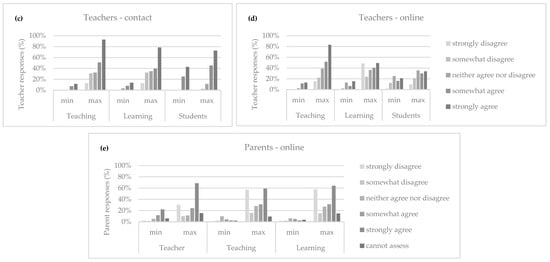
Figure 2.
Minimum and maximum response values from students (a—contact; b—online), teachers (c—contact; d—online), and parents (e—online) across the respective subscales of the survey questionnaire (Teaching, Learning, Teacher, Students).
4.3. CHAID Analysis of Perceptions Across Participant Groups
These results reflect patterns identified through the CHAID analysis, conducted across questionnaire subscales and between the two teaching modalities (contact, C and online, O).
Figure 2 displays the minimum and maximum response values for each subscale of the survey (Teaching, Learning, Teacher, and Students)—from participants in our study: students, teachers and parents. This visualization helps identify the range of perceptions held by each group across teaching modes (C vs. O).
To examine potential differences in perceived teaching effectiveness between contact and online modes, we analyzed paired sets of responses (C vs. O). We used the CHAID decision tree method to identify statistically significant predictors of reported understanding of biological content.
The dependent variables in our CHAID models are student, teacher, and parent responses to core statements related to understanding biology: Students (Statement S22—“I understood all the content presented in class well”), Teachers (Statement T2—“I tried to make students understand the material, not just memorize it”), Parents (Statement P13—“My child understands the content presented in distance teaching”). Figure 3 highlights the distribution of responses to these key statements.
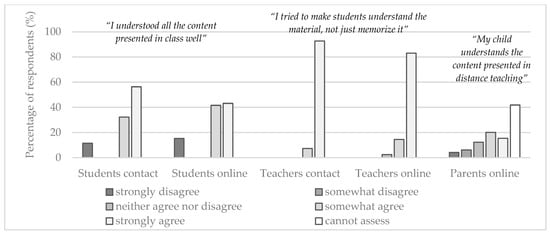
Figure 3.
Participants’ responses to statements in questionnaires regarding understanding of biological content during teaching.
These dependent variables guided the classification and partitioning process of the CHAID decision trees. All other questionnaire items were treated as independent predictors and organized based on their statistical association with these outcomes.
4.3.1. Student Perspective
In contact teaching, students identify the time needed to solve tasks and learn during the lesson as the teacher’s most significant influence on their understanding. The root node of this decision tree Enough time to learn is connected to two internal nodes Encouraging thinking while learning, which ends with the terminal nodes Monitoring lesson progress and Checking learning, and the internal node Tasks to encourage thinking, which ends with the terminal node Knowing the student (Figure 4, Table A4). The students who agree (branch 2; 58%) that the teacher had the greatest impact on their understanding by giving them enough time to learn (branch 2; 69%) indicate the importance of the thinking stimulation tasks they solved during the lesson (branch 6; 72%). In addition, they state that it is important how well the teacher knows them (branch 12; 73%), which is an important but slightly weaker influence. In contrast, 42% of students (branch 1) believe that the influence of the time the teacher gives them during learning is not crucial for their understanding, but that it is more important to stimulate all students to think (branch 3; 28%). Within this group of students, 18% (branch 8) agree to some extent (70%) that it is important for the teacher to notice any students who are not concentrating on their work, while 38% of students (branch 12) believe that it is important for the teacher to ensure that everyone is following the lesson (85%).
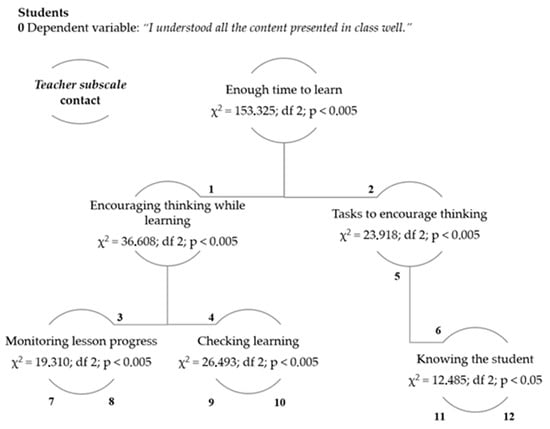
Figure 4.
Decision tree with student responses in the Teacher subscale during contact teaching (the branches of the decision tree are marked with numbers, with a more detailed view in Table A4).
In online teaching, students also identify the time they have to complete assignments and learn during the lesson as the most important influencing factor in relation to the Teacher subscale. The root node Enough time in learning is associated with two internal nodes Tasks to stimulate thinking, which ends with the terminal node Encouragement in learning, and the internal node Insight into behavior, which ends with the terminal nodes Knowing the student and Keeping attention on tasks (Figure 5, Table A5). In online teaching, students who agree (branch 3; 55%) that the teacher influenced their understanding by providing enough time to learn note the importance of the teacher’s insight into student behavior. Students who fully agree with the influence of time (branch 8; 34%) emphasize the importance of the teacher managing to keep students’ attention on tasks, with a slightly lower level of agreement that it is important that the teacher knows the students well (branch 6; 18%). In contrast, 37% of students (branch 1) believe that the influence of time is less important to their understanding but tend to emphasize the tasks set by the teacher in class to stimulate thinking, while the students who agree more (branch 4; 19%) believe that the teacher encourages them in their learning.

Figure 5.
Decision tree with student responses in the Teacher subscale during online teaching (the branches of the decision tree are marked with numbers, with a more detailed view in Table A5).
Students cite the importance of simple lesson follow-up as the most important influence on contact teaching and their understanding. The root node of the decision tree Follow-up of the lesson ends with the end node Motivation with thinking tasks but is also connected to the internal node Concentration on learning, which appears as a test node in two forms, i.e., leads to different terminal nodes depending on the students’ opinion. One internal node related to the partial agreement response ends with the Stimulating environment end node, while the other internal node related to the full agreement response ends with the Successful learning and Enjoyable teaching end nodes (Figure 6, Table A6). The focus on learning occurs in two nodes at the first level of divergent opinions. The majority of students who fully agree with the importance of following lessons (branch 2; 59.1%) emphasize the importance of focusing on learning (branch 8; 43.6%), which for 33.3% of students is crucial for learning success and is enabled by a pleasant atmosphere in class (branch 16; 35.5%). Students who tend to agree with the importance of following lessons (branch 1; 29.1%) consider a stimulating environment during learning to be important in order to concentrate on learning. Of the 11.8% of students who disagree that following lessons is important for understanding, 81.9% (branch 9) believe that motivation is not important when solving thinking tasks.
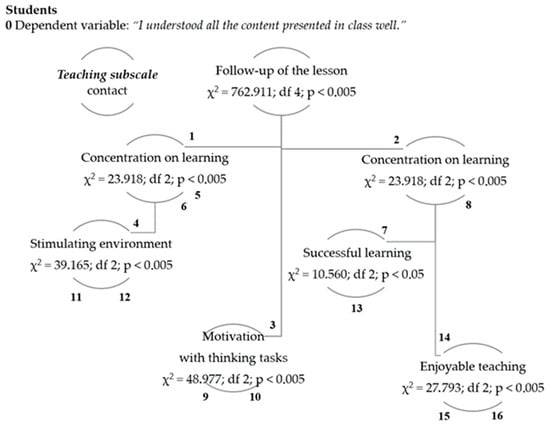
Figure 6.
Decision tree with student responses in the Teaching subscale during contact teaching (the branches of the decision tree are marked with numbers, with a more detailed view in Table A6).
The students emphasize the importance of simply following the lessons as the most important influencing factor for online lessons as well (Figure 7). The root node of the decision tree for online teaching is Following the lesson and ends with the terminal node Activity in the lesson, but it is also connected to two internal nodes (Figure 7, Table A7). The internal node Interestingness of teaching ends with the terminal node Stress-free lessons, related to undecided answers of partial agreement or clear answers of agreement or disagreement. The Focus on learning of the internal node ends with the terminal nodes Attention to teaching and Interestingness of teaching. Students who find it important to follow the lessons to understand the teaching content during online teaching (branch 2; 38.2%) indicate that they find it easy to focus on learning. In total, 88% of students who find it easy to concentrate listen to and follow the lessons attentively (branch 6; 25.9%), while the rest are influenced by the interestingness of the lessons. Interest in the lesson is also important for 43% (branch 1) of students who think that it is important to follow the lesson in order to understand it, and for all of them it is most important that there is no stress during the lesson. For the students for whom it is not important to follow the lessons (branch 3; 18.9%), it is important to have quality activities in class in which they can participate and have the opportunity to ask questions if something is not clear to them.
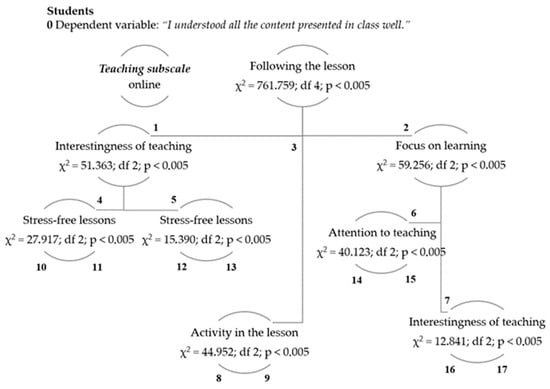
Figure 7.
Decision tree with student responses in the Teaching subscale during online teaching (the branches of the decision tree are marked with numbers, with a more detailed view in Table A7).
In contact teaching, students cite the interestingness of the tasks they work on in class as the most important influence of learning on their understanding. The root node of this decision tree, Interestingness of tasks, is connected to two internal nodes. The internal node Variety of tasks ends with the terminal node Discussion of research results, while the internal node Independence in solving tasks, ends with the terminal node Interestingness of teaching content (Figure 8, Table A8). Students who fully agree that the interestingness of the tasks during contact teaching is important for understanding the learning (branch 3; 51.6%), find it important that they can solve the tasks themselves without problems (branch 7; 33.5%) and that they are interested in what they are learning (branch 11; 29.2%). For the students for whom the interestingness of tasks is more important for understanding (branch 1; 41%), the variety of tasks they are given in class is important, but also that they discuss the results of the research carried out in class (branch 4; 26.7%).
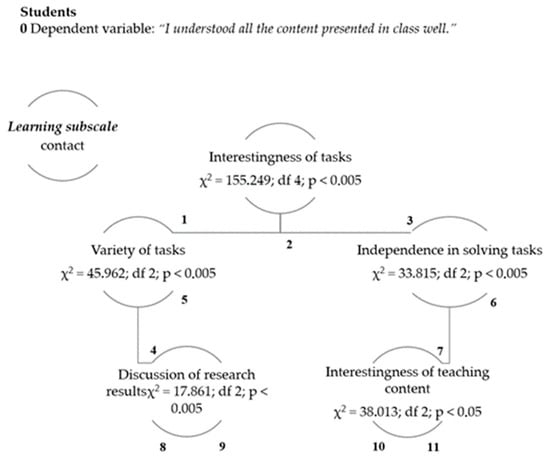
Figure 8.
Decision tree with student responses in the Learning subscale during contact teaching (the branches of the decision tree are marked with numbers, with a more detailed view in Table A8).
Unlike in contact teaching, where interesting tasks are most important to them, students in online teaching cite the interestingness of the teaching content as the most important influence on learning. The root node of the decision tree Interestingness of teaching content ends with the terminal node Activity in class, but it is also connected to two internal nodes (Figure 9, Table A9). The internal node Independence in solving tasks ends with the terminal node Active participation in class and Satisfaction with the learning method, while the internal node Completion of tasks in class ends with the terminal node Independence in solving tasks. Students who fully agree with the importance of interesting tasks for understanding in online learning (branch 3; 41.8%) confirm that they have completed all tasks in class (branch 10; 33.9%) and that it is important for them that they were able to solve the tasks themselves. For the students who consider interest in the course content to be rather important (branch 1; 48.3%), satisfaction with the learning method is less important (branch 6; 9.3%), while active participation in class is important for the majority (branch 4; 34.7%). For a very small number of students, the interestingness of the teaching content is not important for learning with understanding (branch 2; 9.9%), but the variety of tasks they create is important to them and not all students create the same tasks during class.
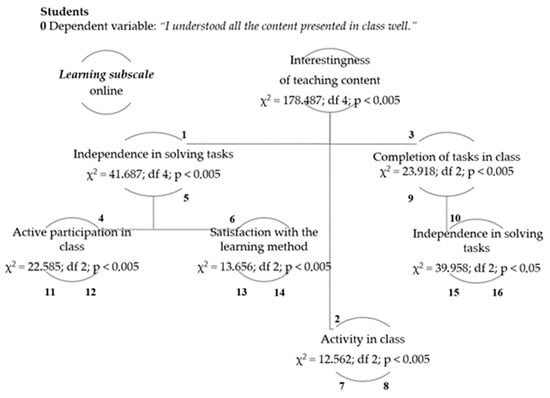
Figure 9.
Decision tree with student responses in the Learning subscale during online teaching (the branches of the decision tree are marked with numbers, with a more detailed view in Table A9).
4.3.2. Teacher Perspective
During contact teaching, teachers point out that completing tasks during teaching is the only influence on understanding in relation to Student subscale. The root node Completion of tasks during teaching of this decision tree is also the terminal node (Figure 10, Table A10). Of the 55.6% (branch 2) of teachers who are fully committed to enabling students to understand the teaching content in their teaching, only 1.4% tend to agree, while 98.6% of teachers fully agree that students’ understanding depends on their willingness to complete tasks in class. However, 44.4% (branch 1) of teachers are still not entirely sure that students’ understanding depends only on their willingness to complete tasks in class. In the case of online teaching, all elements are grouped into a single class, and the root node Emphasis on students’ understanding of teaching has no outgoing branches (Figure 10, Table A11). This indicates that teachers uniformly perceive their effort to support student understanding, with no significant variation linked to student characteristics. However, only 16.9% of teachers believe that their influence on teaching is partially important for students’ understanding in an online setting.
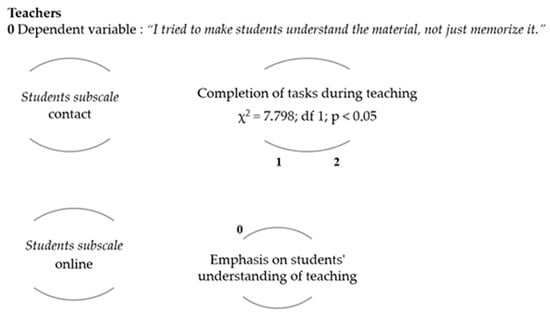
In contact teaching, within the Teaching subscale, the most significant influence—apart from the teacher’s efforts to ensure that students understand the content—is the teacher’s satisfaction with the instruction provided, with 98.6% of teachers fully agreeing with this statement. The root node Satisfaction with teaching in this decision tree is also the terminal node (Figure 11, Table A12). In online teaching, within the Teaching subscale, apart from the teacher’s efforts to ensure that students understand the teaching content, the most significant influence is the importance of encouraging students to solve tasks. Also in this decision tree, the root node Encouraging students to solve tasks is the terminal node (Figure 11, Table A13).
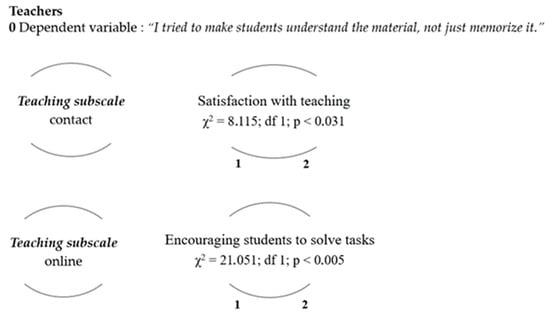
In contact teaching, all elements belong to the same class within the Learning subscale, and the root node Emphasis on understanding in teaching has no outgoing branches (Figure 12, Table A14). This suggests that teachers view their own efforts to ensure students’ understanding of the teaching content as the most significant influence on learning. Furthermore, only 7.3% of teachers believe that their influence on students learning and understanding through teaching is partially important. The root node Learning based on research results of this decision tree is also the terminal node (Figure 12, Table A15). In online teaching, learning based on students’ research findings is the most significant influencing factor, next to teachers’ efforts to ensure that students understand the teaching content, with 92.7% of teachers fully agreeing.
4.3.3. Parents’ Perspective
Parents point out the interestingness of teaching as the most important influence teachers have on their children’s understanding of online teaching and learning. The root node of this decision tree Interestingness of teaching ends with the terminal node Teacher’s video lessons (Figure 13, Table A16). For the majority of parents (62.8%), it is most important that the method of teaching is interesting so that their children understand the teaching content. In contrast, some disagree or cannot determine the importance of the interestingness of the teaching for understanding (branch 2; 23.6%), and they believe that it is important whether the teacher has created his video lessons for distance teaching and learning.
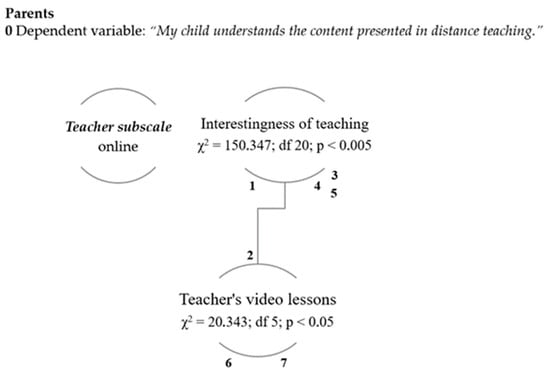
Figure 13.
Decision tree with parent’s responses in the Teacher subscale during online teaching (the branches of the decision tree are marked with numbers, with a more detailed view in Table A16).
Within the Teaching subscale, parents cite ease of learning as the most important influence on their children’s understanding of online teaching and learning. The influence of easy learning divides parents into three groups, so that the root node of this decision tree Easy learning ends with three terminal nodes (Figure 14, Table A17). Two of the terminal nodes Independent task solving are related to parents’ partial or full agreement with the importance of easy learning. The third terminal node Good focus on learning refers to the responses of parents who cannot assess the difficulty with which their child followed the lessons. Both parents who somewhat agree (branch 1; 22%) and parents who fully agree (branch 4; 15.7%) recognize, albeit separately, the importance of their child completing tasks independently during lessons as the most important influence on the success of understanding achieved. Parents who cannot assess the importance of following lessons slowly for achieving understanding are most strongly represented (branch 3; 34.6%), and they recognize that it is an important influence that the child can easily concentrate on learning, although those who cannot assess this also dominate among them (branch 9; 23.1%).
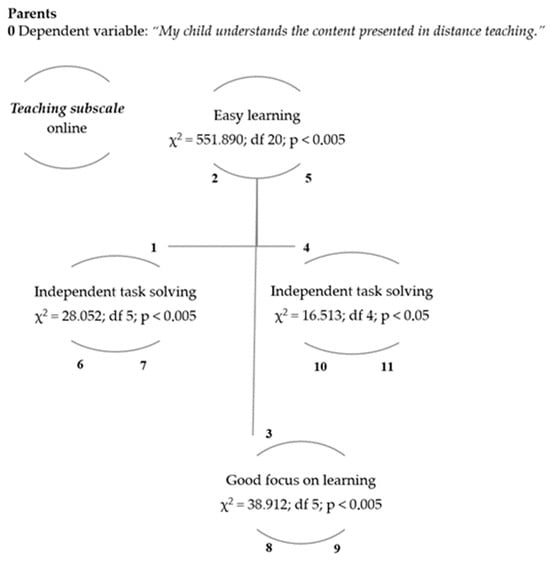
Figure 14.
Decision tree with parent’s responses in the Teaching subscale during online teaching (the branches of the decision tree are marked with numbers, with a more detailed view in Table A17).
Within the Learning subscale, parents identify their satisfaction with their child’s learning during online instruction as the most significant factor influencing their child’s understanding of online teaching and learning. The root node Satisfaction with learning ends with the terminal node Independent observation and research and Stimulating teaching environment (Figure 15, Table A18). Parents who are mostly dissatisfied with online teaching (branch 1; 45.9%) emphasize the great importance of independent observation and research of phenomena that students should carry out at home or in their immediate environment. Parents who are completely satisfied with online teaching or are unable to assess it (branch 3; 33.2%) believe that the greatest influence on understanding is the environment in which the teaching takes place and which encourages their child to work.
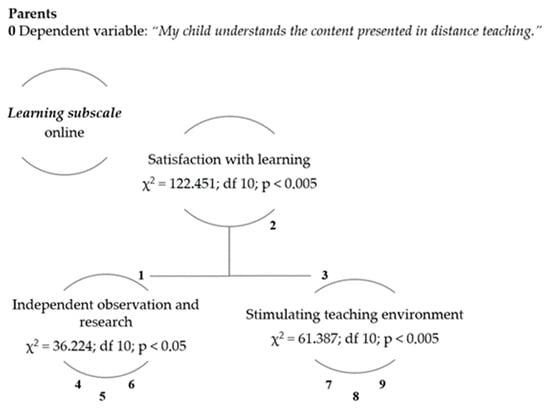
Figure 15.
Decision tree with parent’s responses in the Learning subscale during online teaching (the branches of the decision tree are marked with numbers, with a more detailed view in Table A18).
4.4. Key Factors Influencing Student Understanding in Contact and Online Biology Teaching
Table 3 presents the most influential factors affecting student understanding of biological content for each respondent group—students, teachers, and parents—under both contact and online teaching conditions.

Table 3.
Key predictors of student understanding across respondent groups (students, teachers, parents) and modes of instruction as identified by CHAID decision-tree analysis. Based on CHAID decision-tree models, this table highlights the subscale items (Teacher, Teaching, Learning, and Students) with the strongest influence on reported student understanding in both contact and online biology teaching contexts.
Student responses suggest minimal variation in key factors between the two modalities (contact vs. online). Students consistently identified sufficient instructional time, engagement with instructional content and interesting learning activities as critical for understanding. Additionally, they prioritized tasks that prompt cognitive engagement, teacher motivation during instruction, and sustained focus—especially through independent completion of tasks, which they view as instrumental in developing deeper conceptual comprehension (Table 3).
Teachers placed a strong emphasis on promoting understanding rather than memorization, as indicated by the subscale item on instructional emphasis (Table 3). In both teaching modalities, they highlighted the importance of students completing tasks during lessons. However, in the online format, teachers additionally stressed the value of encouraging autonomous task-solving. Significantly, online teaching was associated with greater emphasis on research-based learning, whereas in contact teaching, the priority remains ensuring that students achieve conceptual understanding by any effective means.
Parents emphasized the relevance of differentiated instruction tailored to class level and individual learning needs, specifically preferring custom-made teacher video lessons over pre-fabricated educational materials. They also emphasized the importance of independent observation and inquiry, which aligns with teacher-reported prioritization of research-based learning. Parents further identified ease of learning, learning satisfaction, and a stimulating instructional environment as critical to their child’s understanding of biology content (Table 3).
5. Discussion
5.1. Insights from Post-Instruction Biology Performance Assessments
Prior to the COVID-19 pandemic, the typical average completion rate of written biology tests in Croatia was approximately 40% (Garašić et al., 2013). Among the most successful 8th grade students who participated in the 2015 national biology knowledge contest, the average score was 62%, with 45% correctly solving reproductive tasks and 40% successfully addressing higher-cognitive-level items—though these participants were notably highly motivated (Lugar & Mustać, 2016). Conversely, the average score on the national biology test for 4th-grade gymnasium students in 2015 was just 37%, with the test emphasizing conceptual understanding and higher-order tasks (Grgurić et al., 2017).
More recently, national exam data for 2025 show average biology test scores of 55% in the 8th grade and 54% in the 4th grade of secondary school (Filipović, 2025a, 2025b)—results that are only slightly higher (by 2–5 percentage points) than the average 48% score observed in the current study after intensive online instruction. This suggests that, despite the shift to online teaching during 2020, students’ biology knowledge remained only marginally weaker compared to national averages of 2025. Therefore, H1 is broadly supported: retention test performance after intensive online teaching was slightly lower than with contact teaching.
When focusing on higher-order conceptual understanding, the discrepancy between online and contact instruction becomes more pronounced. For 8th graders, post-online instruction understanding was about 6% lower than in earlier observations (Lugar & Mustać, 2016). Among gymnasium students (4th secondary grade), the gap in performance on higher-order tasks reached 21%, signaling a substantial decline in conceptual understanding. This trend aligns with the study’s finding that students performed markedly worse on conceptual tasks than on reproduction tasks—likely due to reduced exposure to cognitively demanding tasks during online instruction. Again, this supports H1 regarding poorer outcomes on conceptual understanding tasks after online teaching.
Previous research (e.g., Bulić, 2018) found no statistically significant differences between contact and online instruction when all cognitive levels were compared post-instruction. However, during the 2020 online teaching period, biology teachers received support from the Ministry of Science and Education (MZO, 2020), including standardized video lesson materials produced with validation from scientific and pedagogical experts. These model materials motivated teachers to create tailored video lessons for their own students—something also reported by parents in this study.
Teachers recognized that interactivity was essential to engage students learning individually at home (Štargl et al., 2020). However, while lesson materials were well-structured and grounded in research results, this focus inadvertently reduced students’ opportunities for autonomous task solving, which is essential for developing conceptual understanding. Assigning tasks for independent completion after lessons—common practice under online instruction—also limited timely feedback, further hindering progress in understanding.
5.2. Interpreting Perceptions of Contact Versus Online Biology Teaching
Both students and teachers generally express positive views on biology teaching and learning; however, there is noticeably less agreement between the two groups regarding online biology teaching compared to contact teaching. In contrast, parents in our study showed a balanced distribution of positive and negative opinions regarding online teaching and learning of biological content. Teachers showed the highest levels of agreement with the statements, followed by students, while parents expressed the least agreement. This trend is also reflected in the decision tree model accuracy, which ranks the significance of opinions on understanding biology education accordingly. Supporting this, Mapulanga and Bwalya (2024) also found that teachers held more positive perceptions of the teaching and learning activities used in biology teaching than students did.
Students generally felt that they had understood the teaching content; however, many expressed disagreements with the effectiveness of online teaching. Kolawole and Kehinde (2022) reported that most students found the virtual biology lessons effective during quarantine, suggesting that students’ perceptions may vary depending on the context or quality of teaching. While all teachers aim to support student understanding, fewer seem to be aware that their online teaching may not fully achieve this goal. This could be due to the belief identified by Bartková et al. (2024) that online teaching is only suitable for theoretical topics in biology, which is shared by both teachers and students. In contrast, parents, who have limited insight into the teaching process, give mixed ratings of their child’s understanding, with most unable to assess how effectively online teaching supports understanding.
According to students, their understanding during contact teaching largely depends on whether they can easily follow the lesson, engage with interesting tasks that stimulate thinking, and have enough time to solve them independently. It also matters how well the teacher knows them personally. Mapulanga and Bwalya (2024) found that students generally agreed with teachers on the importance of facilitating teaching and learning in biology. However, students reported perceiving the lessons as less difficult than teachers did, which may explain why many students in this study emphasized the importance of a slower teaching pace. Students who are able to keep up with the lesson pace as planned by the teacher value the encouragement to think critically and recognize the teacher’s role in noticing when students are disengaged, ensuring everyone is following along. Those who prefer a slower pace often highlight the need for a focused and comfortable classroom atmosphere that also stimulates learning. In contrast, students who do not see the need for a slower pace tend to place less importance on motivational tasks that require deeper thinking. Students who express interest in the tasks particularly appreciate their variety and the opportunity to discuss research findings in class. This supports the recommendation by Mirosavljević et al. (2024), who suggest that teachers should design lessons that actively encourage students to ask questions, as thoughtful questioning fosters curiosity, promotes engagement, and motivates deeper learning.
In online teaching, students state they improve their understanding when they can follow lessons at a slower pace, work on engaging content and take the time they need to complete tasks independently—conditions that help them focus on learning more easily. However, maintaining student motivation and engagement online remains a major challenge, as highlighted by Bartková et al. (2024). Anwar et al. (2022) also emphasized the importance of innovation in online learning design, noting that student interest is not constant and must be continually supported through creative and engaging instruction. As in contact teaching, students value when the teacher knows them well. But in online contexts, they also place particular importance on the teacher’s ability to monitor student behavior, maintain attention on tasks and reduce stress during lessons. Bartková et al. (2024) also emphasized that students’ attention wanes especially when there is a lack of feedback or when external distractions are present.
For students who place less emphasis on time or lesson content as factors in understanding, it is the thinking-based tasks and the teacher’s encouragement that matter most. These findings align with Bartková et al. (2024), who emphasized that meaningful interaction—both among students and between students and teachers—is crucial for effective online learning. Nadeak (2020) similarly argued that teacher-student interaction helps reduce psychological distance, thereby enhancing learning. Finally, for students who struggle to follow online lessons, active participation, engaging classroom activities, and task variety—particularly when students are not all assigned the same work—are key to promoting understanding.
Teachers’ opinions on contact teaching are largely consistent. Nearly all emphasize their efforts to ensure students’ understanding and satisfaction as the key factor influencing how well students understand the content. Supporting this view, Mapulanga and Bwalya (2024) found that teachers often perceive their teaching more positively than students do. Furthermore, while most teachers in our study consider task completion essential for student understanding, fewer than half believe that understanding depends solely on completing tasks, and about one in ten feel their own teaching has only a partial impact on learning outcomes. Despite the presence of group and individual activities in biology classes, research by Mirosavljević et al. (2024) shows that traditional teaching methods—such as teacher-led presentations and questioning—still dominate classroom practice. These views suggest that some teachers recognize the critical role of pedagogical content knowledge (i.e., the ability to transform subject matter into teachable content) as emphasized by Magnusson et al. (2002), Loughran et al. (2008), and Chapooa et al. (2018).
In online teaching, teachers primarily emphasize their efforts to support student understanding, yet only one in ten believe their teaching has a significant impact on students’ understanding in this context. In contrast to contact teaching, teachers emphasize the importance of encouraging students to solve tasks, which is affirmed by almost all teachers. In line with this, Bartková et al. (2024) found that it is important for teachers to find ways to encourage student participation in online learning, e.g., by implementing strategies such as setting clear expectations for class participation, providing interesting content and offering opportunities for interaction and collaboration among students with frequent feedback.
Parents often assume that their children’s understanding during online teaching and learning is primarily influenced by their satisfaction with the learning experience, but this is not the case. Those parents who are satisfied believe that the most important factor in their child’s understanding is a learning environment that promotes concentration, presents content in an engaging and accessible way, and helps the child focus on the material. These parents also emphasize the importance of their child completing tasks independently during class, which aligns with Nadeak’s (2020) finding that parents who are satisfied with their child’s progress place great value on independent work. In contrast, parents who are dissatisfied with online teaching emphasize the need for independent observation and research of phenomena at home or in their immediate environment. Uludağ and Erkan (2023) support this view, noting that parents see the value of integrating science activities both in the classroom and in the out-of-school environment and are willing to become more involved in the educational process, especially through teacher guidance. Interestingly, parents also recognize the importance of teachers creating their own materials and video lessons for distance learning. However, the majority of parents do not recognize the significant impact of online teaching on their children’s understanding.
In both contact and online teaching, it is important to give students sufficient time to independently solve a variety of stimulating (i.e., thought-provoking) tasks, while ensuring that lessons are engaging and actively involve students in a supportive learning environment. Emphasizing independent observation and exploration of phenomena helps students to focus and develop a deeper understanding of the content. To accomplish this, teachers must make a conscious effort to promote understanding by developing their own teaching materials and tailoring lessons to students’ abilities, interests, achievement levels, and personalities. If teachers know their students well, they can adapt lessons accordingly and encourage further exploration of classroom topics. When designing high-quality biology lessons—whether for contact or online formats—these factors must be taken into account. Bartková et al. (2024) similarly emphasize the importance of continuously evaluating the effectiveness of online teaching methods and materials and using innovative strategies to promote student engagement in biology classes. As Mapulanga and Bwalya (2024) emphasize, future research should also investigate how teachers’ awareness of the discrepancy between their perceptions and those of their students can lead to improvements. The improvement of biology teaching should be based on these findings.
When reviewing the results of this study, it is important to consider the aspects that may have influenced the results. Although the purpose of this study was not to investigate the concept of understanding, but rather to explore the interrelationships between the experience of understanding during learning and other factors of teaching and learning, the question of whether the participants in the study clearly experienced the term “understanding” should still be considered as a limiting factor in the study. Hsu et al. (2021) point out that respondents outside the biology classroom define understanding as a demonstration of mastery of material related to classroom assessment, whereas biology teachers focus on “performance based on intrapersonal learning standards” when assessing student learning (Svinicki, 2010). Additionally, the way teachers in our sample conceptualize “understanding” should inform the training and professional development of biology teachers. Their views support the idea that true understanding involves deep mastery of a concept and the ability to connect it to broader frameworks—both of which are essential for students to apply knowledge to new situations. A consistent definition of “understanding” allows teachers to clarify their expectations and develop teaching tools that enhance students’ understanding of concepts, as recommended by Hsu et al. (2021). This approach also helps to align learning outcomes with teaching and the learning context, making education more meaningful and relevant to everyday life.
Furthermore, the students and teachers in this study completed the questionnaire in pairs, which may have influenced their responses. This method allowed them to partially compare and possibly match their answers, which is a limitation of the study. The subjectivity of the participants must also be taken into account—teachers might overestimate their effectiveness, while students might underestimate their teachers, as noted by Fitzgerald et al. (2020). Moreover, the exclusive reliance on categorical, closed-format questions limited the opportunity to explore participants’ reasoning behind their perceptions. The three-point measurement scale employed for younger students—designed for developmental appropriateness—may have skewed responses toward agreement by eliminating a neutral midpoint. Further, we did not account for demographic or contextual variables such as gender or parent and teacher qualifications, which could moderate perceptions and outcomes.
Nevertheless, by triangulating insights from students, teachers and parents, this study provides a holistic perspective on how both contact and online teaching modalities affect students’ understanding of biology content. Contrary to initial expectations, respondents’ perceptions showed remarkably little difference between the teaching formats. The study emphasizes that the teaching modality alone is not decisive for the perception of effectiveness. Rather, the cognitive depth and quality of learning experiences determine whether students internalize and apply biological concepts. The most important factors for understanding—including sufficient instructional time, engaging learning activities, and teacher encouragement—were consistently considered important in both (contact and online) teaching formats. These findings can inform teacher training, curriculum development, and digital integration strategies aimed at optimizing conceptual learning in both online and contact settings.
6. Conclusions
This study had three main objectives: to assess student performance on knowledge reproduction and conceptual understanding tasks in both contact and online biology teaching (O1); to examine the perceptions of teaching, learning, and student understanding from the perspectives of students, teachers, and parents during online biology teaching (O2); and to identify factors contributing to student understanding in both teaching modalities as perceived by all three groups of participants (O3). The associated hypotheses (H1–H3) guided the investigation of differences in student outcomes and perceptions across these groups and teaching modes.
Our findings support hypothesis (H1) that student performance on post-instruction assessments was generally lower after intensive online teaching compared to contact teaching, with the greatest deficits observed in tasks requiring conceptual understanding. This suggests that while online teaching may be effective in supporting knowledge reproduction, it may not be able to promote deeper cognitive engagement and independent application of biological concepts. The structured and research-based nature of online teaching, while beneficial in many ways, may inadvertently hinder the development of self-regulated learning and reduce opportunities for timely feedback.
With regard to the perception of teaching effectiveness (H2), we found differences between the participant groups. Teachers were consistently the most positive about teaching biology, emphasizing their didactic efforts and facilitation of meaningful learning activities. Students were generally positive, but less so than teachers, particularly in relation to online teaching. Parents exhibited the widest range of opinions, reflecting both appreciation and concern about the quality and effectiveness of online biology teaching. This diversity emphasizes the importance of triangulating perspectives to gain a holistic understanding of educational experiences.
Consistent with hypotheses H3a–H3c, factors influencing students’ understanding revealed both similarities and differences between the contact and online modalities. Students emphasized the importance of sufficient instructional time, engaging content, interesting learning activities, teacher motivation and the ability to maintain concentration—particularly through independent task completion. Teachers prioritized promoting understanding over memorization and placed more emphasis on independent task solving during online teaching, highlighting the role of research-based learning. Parents emphasized the need for differentiated instruction tailored to individual learning needs, preferred teacher-produced video lessons, and stressed the importance of independent enquiry and a stimulating learning environment.
Taken together, these findings emphasize the need to combine the interactive strengths of contact teaching—such as direct engagement and immediate feedback—with the flexibility and structured approaches of online teaching. Effective hybrid biology teaching should focus on cognitively rich, student-centered tasks supported by timely feedback to promote deeper conceptual understanding and critical thinking skills.
Teacher education should prioritize the development of instructional strategies that promote higher-order thinking and self-directed learning, especially in online and hybrid environments. In addition, policy makers and educators should recognize the potential of digital tools not only as delivery mechanisms, but also as motivational tools that encourage inquiry and enthusiasm for biology and science more broadly.
Ultimately, this study confirms that the success of biology teaching—whether contact or online—depends on the intentional design of research-based, student-centered learning experiences that promote autonomy, engagement, and meaningful understanding. By explicitly considering the perspectives of students, teachers, and parents, and linking these perspectives to student performance outcomes, our findings offer valuable, generalizable insights for improving science teaching in face-to-face and online teaching modalities.
Author Contributions
Conceptualization, I.R., and M.S.P.; methodology, I.R., M.S.P. and S.Š.Š.; software, I.R.; validation, I.R., M.S.P. and S.Š.Š.; formal analysis, I.R.; investigation, I.R.; resources, I.R.; data curation, I.R., M.S.P. and S.Š.Š.; writing—original draft preparation, I.R. and M.S.P.; writing—review and editing, I.R., M.S.P. and S.Š.Š.; visualization, I.R.; supervision, I.R., M.S.P. and S.Š.Š.; project administration, I.R.; funding acquisition, I.R. All authors have read and agreed to the published version of the manuscript.
Funding
This research was funded by Croatian Science Foundation, grant number IP-CORONA-2020-12-3798.
Institutional Review Board Statement
The study was conducted in accordance with the Declaration of Helsinki, and approved by the Ethics Committee of Faculty of Science, University of Zagreb and Ministry of Science and Education, Republic of Croatia (class 602-01/21-01/00451, ID 533-05-21-0004, 16 July 2021).
Informed Consent Statement
Informed consent was obtained from all subjects involved in the study.
Data Availability Statement
The data presented in this study are available on request from the corresponding author.
Acknowledgments
We would like to thank all collaborators who contributed to the success of the project implementation, the school principals who agreed to participate in the project activities, and the teachers and students who participated in the project implementation. The statistical calculations were carried out using the SPSS 22 software package (IBM, 2013) with the kind support of the staff of the Center for Research and Development of Education (CIRO) of the Institute for Social Research in Zagreb (IDIZ), for which we would like to express our sincere gratitude. The authors gratefully acknowledge the University Computing Centre (SRCE) for hosting and technically supporting the MoD Moodle platform used in the administration and data collection of online retention assessments, thus enabling this study’s measurement of student biology understanding through a reliable and nationally scaled e-learning infrastructure.
Conflicts of Interest
The authors declare no conflicts of interest.
Appendix A
Appendix A contains statements answered by students (Table A1) and teachers (Table A2) on two occasions regarding contact and online teaching, and by parents (Table A3) regarding the online teaching method. The percentages of responses according to the corresponding response (i.e., Likert) scale choices are also shown, along with the statements of the questionnaires regarding contact and online classes according to the subscales of the questionnaires for students (Figure A1, Figure A2 and Figure A3) and teachers (Figure A4, Figure A5 and Figure A6), and the responses of parents (Figure A7) regarding the online teaching of biology content. The original negative answer form is shown in the figures.

Table A1.
A questionnaire in which students expressed their opinions on contact and online teaching, with statements divided into subscales: Teacher, Teaching, and Learning. To enable comparison across participant groups using the CHAID decision tree analysis, negative questionnaire responses were recoded into a positive format; therefore, both the original and recoded versions are presented in this table, separated by a slash (e.g., S21–S24, S31, S32).
Table A1.
A questionnaire in which students expressed their opinions on contact and online teaching, with statements divided into subscales: Teacher, Teaching, and Learning. To enable comparison across participant groups using the CHAID decision tree analysis, negative questionnaire responses were recoded into a positive format; therefore, both the original and recoded versions are presented in this table, separated by a slash (e.g., S21–S24, S31, S32).
| Subscale | Variable | Statements |
|---|---|---|
| Teacher | S1 | The teacher shows warmth towards all of us. |
| S2 | The teacher makes sure that we all follow the lesson. | |
| S3 | The teacher is aware of each of our feelings. | |
| S4 | The teacher knows us well. | |
| S5 | The teacher tried to give tasks and ask questions that made us think. | |
| S6 | The teacher tried to make us understand what we were learning, not just memorize it. | |
| S7 | The teacher had an insight into what was happening in the classroom at all times. | |
| S8 | The teacher tried to make us enjoy learning new content. | |
| S9 | The teacher gave everyone enough time to explore and gain an understanding of the new learning. | |
| S10 | The teacher noticed students who were not focused on their work. | |
| S11 | The teacher encouraged us to think about our learning. | |
| S12 | The teacher took care of the problems of all his students. | |
| S13 | The teacher ensured that the tasks he gave us encouraged all the students to think. | |
| S14 | The teacher successfully maintained the students’ focus on the work tasks. | |
| S15 | The teacher encouraged us to persevere until we reached the correct solution to the task. | |
| Teaching | S16 | I liked learning about nature and living things. |
| S17 | I found the lessons interesting. | |
| S18 | I enjoyed learning new things about nature and living things. | |
| S19 | I felt comfortable in the lessons. | |
| S20 | The environment in which the lessons took place encouraged me to work. | |
| S21 | I found it difficult to follow the lessons. /I found it easy to follow the class. | |
| S22 | I did not understand the content presented in class well. /I understood all the content presented in class well | |
| S23 | It was difficult for me to concentrate on learning. /I found it easy to concentrate on studying. | |
| S24 | The class was stressful for me. /The classes weren’t stressful for me. | |
| S25 | I learned a lot in class. | |
| S26 | I listen carefully, and I follow the class. | |
| S27 | I am active in class. (I actively engage in class discussions and assignments. I respond to the teacher’s questions and seek clarification when something is unclear to me.) | |
| S28 | I think intensively about the content we cover in class. | |
| S29 | I tried to understand the material we were learning and not just memorize it. | |
| S30 | I independently took notes during class and created tables, diagrams, and graphs. | |
| S31 | I thought about something else in class. /I was following the class and not thinking about anything else. | |
| S32 | In class, I just waited for the time to pass. /I found the class interesting and the class went by quickly. | |
| S33 | I did additional research on the topics covered in class. | |
| S34 | I worked diligently on assignments, because the assignments we did encouraged me to think. | |
| S35 | We studied in groups or pairs. | |
| S36 | In class, we made projects. | |
| S37 | In class, we performed experiments. | |
| S38 | We had organized fieldwork at least once a year. | |
| S39 | The teacher mostly gave a lecture. | |
| S40 | The teacher discussed the topic in addition to the lecture. | |
| S41 | Online classes required more of my effort than in-class classes. | |
| S42 | I learned more with online classes. | |
| Learning | S43 | We learned with demonstration experiments. |
| S44 | We learned from the results of our research. | |
| S45 | We discussed the results of our research. | |
| S46 | We did not always do the same tasks in class. | |
| S47 | We also learned from the tasks that others did. | |
| S48 | The tasks I did were interesting to me. | |
| S49 | I could solve the tasks I did independently without any problems. | |
| S50 | I liked how we learned. | |
| S51 | I completed all the tasks during class. | |
| S52 | I was interested in what we were learning. | |
| S53 | I tried to learn as best I could. | |
| S54 | I actively participated in class. | |
| S55 | I enjoyed participating in the projects and research. | |
| S56 | I regularly completed the tasks assigned for the assignment. |
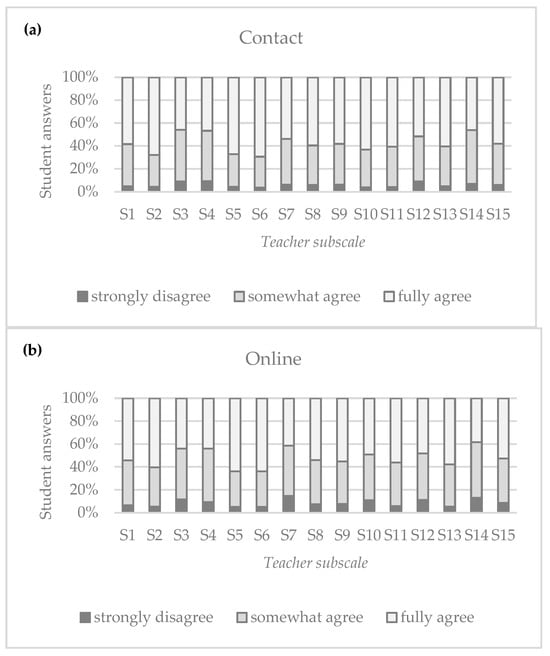
Figure A1.
Student opinion on contact (a) and online (b) implementation of biology teaching—Teacher subscale.
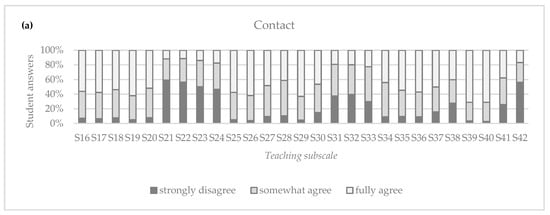
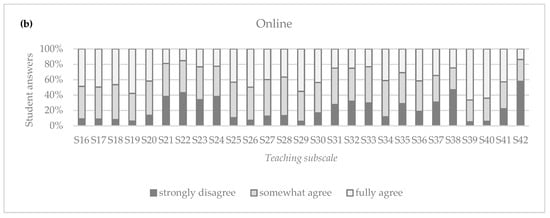
Figure A2.
Student opinion on contact (a) and online (b) implementation of biology teaching—Teaching subscale.

Figure A3.
Student opinion on contact (a) and online (b) implementation of biology teaching—Learning subscale.

Table A2.
A questionnaire in which teachers expressed their opinions on contact and online teaching, with statements divided into subscales: Teaching, Learning, and Students.
Table A2.
A questionnaire in which teachers expressed their opinions on contact and online teaching, with statements divided into subscales: Teaching, Learning, and Students.
| Subscale | Variable | Statements |
|---|---|---|
| Teaching | T1 | I tried to set tasks and ask questions that made students think. |
| T2 | I tried to make students understand the material, not just memorize it | |
| T3 | I consistently gained insight into what was happening in the classroom. | |
| T4 | I showed warmth towards my students. | |
| T5 | I tried to make the students follow the lesson. | |
| T6 | I was aware of my students’ feelings. | |
| T7 | I tried to make students enjoy learning new content. | |
| T8 | I provided students with ample time to explore and understand the new concepts and content. | |
| T9 | I noticed students who were not focused on the work. | |
| T10 | I encouraged students to think about the material. | |
| T11 | I was attentive to my students’ problems. | |
| T12 | I made sure that the tasks I set made students think. | |
| T13 | I was able to keep the students’ attention on the work tasks. | |
| T14 | I encouraged students to persist until they reached the correct solution to the task. | |
| T15 | I empathized with my students. | |
| T16 | I am satisfied with the implementation of the lesson. | |
| T17 | The lesson required a lot of my effort. | |
| T18 | The students learned everything that was expected of them and achieved the learning outcomes. | |
| T19 | They were active and quiet, introverted students. | |
| T20 | I organized the lesson using ready-made materials from textbook publishers or created video lessons provided by the Croatian Ministry of Education. | |
| T21 | I independently created tasks for active teaching. | |
| T22 | I used group and pair work, as well as collaborative learning. | |
| T23 | During group work, I randomly assigned tasks to students without considering their individual differences, such as interests, levels of achievement, types of intelligence, or personality traits. | |
| Learning | T24 | The students learned experientially. |
| T25 | The students learned by discovery. | |
| T26 | The students learned through research learning. | |
| T27 | The students created projects. | |
| T28 | The students created experiments. | |
| T29 | Field teaching was organized for students at least once a year. | |
| T30 | The students learned frontally with lecture teaching. | |
| T31 | Students learned frontally with heuristic conversation. | |
| T32 | Students learned through demonstration experiments. | |
| T33 | Students discussed research results. | |
| T34 | The results of students’ research served as the basis for learning. | |
| T35 | Students with adapted/individualized teaching worked on special tasks. | |
| T36 | Students with adapted or individualized teaching contributed to the learning of the entire class in each lesson. | |
| T37 | Gifted students worked on special tasks during regular classes or at home. | |
| T38 | Gifted students contributed to the learning of the whole class with their conclusions, based on specific tasks they worked on during classes or at home. | |
| Students | T39 | Students readily completed tasks during classes. |
| T40 | Students were interested in learning. | |
| T41 | Students learned according to their abilities. | |
| T42 | Students actively participated in classes. | |
| T43 | Students gladly participated in the development of projects and research. | |
| T44 | Students regularly worked on the tasks assigned for homework. | |
| T45 | Students successfully collaborated in group and pair work, as well as in collaborative learning. | |
| T46 | Students showed interest in additional content in addition to learning. |
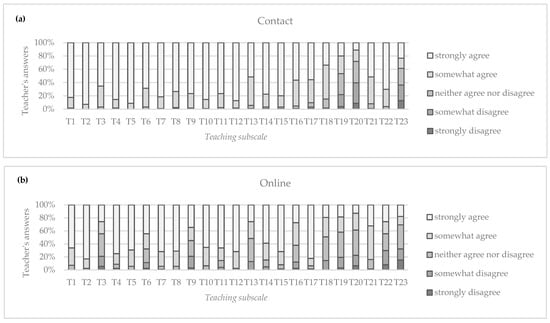
Figure A4.
Teacher’s opinion on contact (a) and online (b) implementation of biology teaching—Teaching subscale.
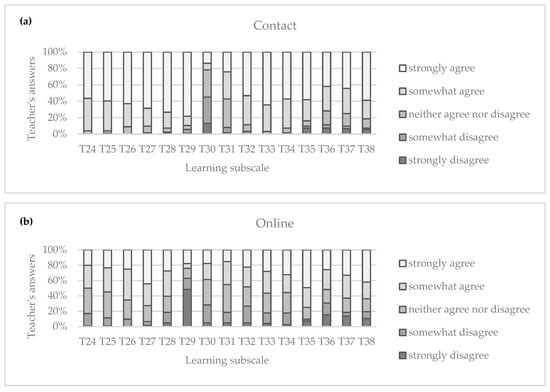
Figure A5.
Teacher’s opinion on contact (a) and online (b) implementation of biology teaching—Learning subscale.
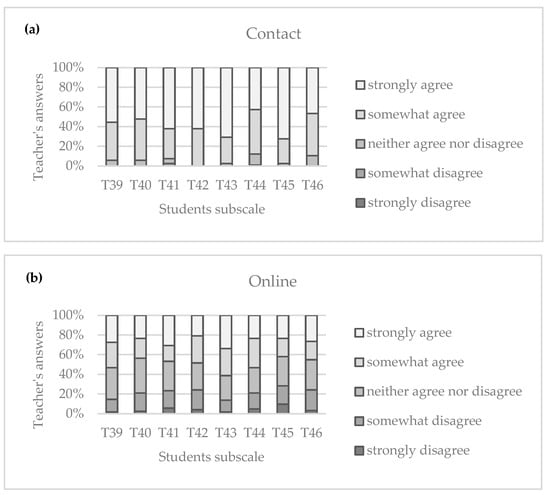
Figure A6.
Teacher’s opinion on contact (a) and online (b) implementation of biology teaching—Students subscale.

Table A3.
A questionnaire in which parents expressed their opinions on online teaching, with statements divided into subscales: Teacher, Teaching, and Learning. To enable comparison across participant groups using the CHAID decision tree analysis, negative questionnaire responses were recoded into a positive format; therefore, both the original and recoded versions are presented in this table, separated by a slash (e.g., P13, P14, P22, P23).
Table A3.
A questionnaire in which parents expressed their opinions on online teaching, with statements divided into subscales: Teacher, Teaching, and Learning. To enable comparison across participant groups using the CHAID decision tree analysis, negative questionnaire responses were recoded into a positive format; therefore, both the original and recoded versions are presented in this table, separated by a slash (e.g., P13, P14, P22, P23).
| Subscale | Variable | Statements |
|---|---|---|
| Teacher | P1 | The teacher gave instructions for independent work with the textbook and assignments. |
| P2 | The teacher prepared presentations with voice or video recordings. | |
| P3 | The teacher recorded his own video lessons. | |
| P4 | The teacher sent links to ready-made video lessons or directed them to their use. | |
| P5 | The teacher mostly gave a real-time lecture. | |
| P6 | In addition to the lecture, they also discussed the topic in class. | |
| P7 | The teacher assigned assignments that the children completed at home. | |
| Teaching | P8 | My child likes to be in class on the subject (Science and Society/Science/Biology). |
| P9 | The distance learning of the subject was interesting for my child. | |
| P10 | My child enjoys learning new things in this subject. | |
| P11 | My child feels comfortable in this subject. | |
| P12 | My child has difficulty following the distance learning in this subject. /My child easily follows the distance learning lessons. | |
| P13 | My child does not understand the content of this subject presented in distance teaching. /My child understands the content presented in distance teaching. | |
| P14 | My child finds it difficult to concentrate on learning this subject. /My child finds it easy to concentrate on learning the lessons. | |
| P15 | My child is comfortable with independent work in the distance learning of this subject. | |
| P16 | My child finds this subject teaching stressful. | |
| P17 | My child gained a lot of knowledge in these classes. | |
| P18 | My child carefully listens and follows along with this subject teaching. | |
| P19 | My child is active in this subject teaching. (Actively engages in the lessons and participates in discussions and assignments. Answers questions posed by the teacher. Asks when something is not clear.) | |
| P20 | My child takes notes independently during this subject teaching. | |
| P21 | My child solves assignments independently during subject teaching. | |
| P22 | My child does something else during this subject teaching. /My child is focused on the lesson and does not engage in any other activities during class. | |
| P23 | My child simply waits for the time to pass during this subject’s lessons. /My child found the lesson interesting, and the lesson passed quickly. | |
| Learning | P24 | My child further explores the biology topics covered in class. |
| P25 | My child works diligently on subject assignments. | |
| P26 | The environment in which this subject teaching takes place encourages my child to work. | |
| P27 | They studied in groups or pairs. | |
| P28 | My child independently observed and investigated certain phenomena at home or in the immediate environment. | |
| P29 | My child made projects. | |
| P30 | My child performed experiments. | |
| P31 | They had organized field trips at least once a year. | |
| P32 | Online classes require more effort and time for my child than contact classes. | |
| P33 | My child learns better with online classes. | |
| P34 | I am pleased with my child’s learning under epidemiological conditions. |
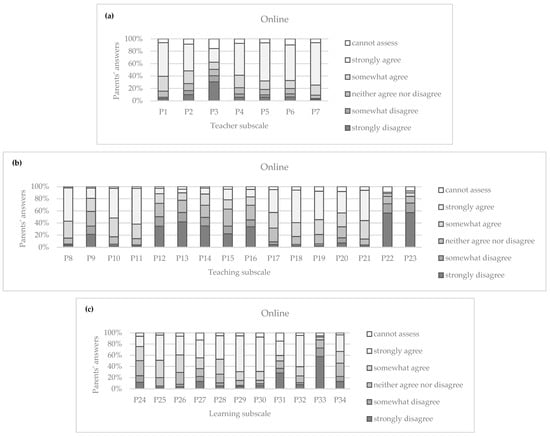
Figure A7.
Parents’ opinion on online implementation of biology teaching—(a) Teacher subscale, (b) Teaching subscale, (c) Learning subscale.
Appendix B
The Table A4, Table A5, Table A6, Table A7, Table A8, Table A9, Table A10, Table A11, Table A12, Table A13, Table A14, Table A15, Table A16, Table A17 and Table A18 represent the decision trees with the percentage of participants’ responses according to the corresponding response (i.e., Likert) scale. The numbers indicate the branches in the decision tree visualizations (Figure 3, Figure 4, Figure 5, Figure 6, Figure 7, Figure 8, Figure 9, Figure 10, Figure 11, Figure 12, Figure 13 and Figure 14).

Table A4.
Decision tree branches with students’ responses in the Teacher subscale during contact classes.
Table A4.
Decision tree branches with students’ responses in the Teacher subscale during contact classes.
| Students—Teacher Subscale (Contact) | ||||||||
|---|---|---|---|---|---|---|---|---|
| Branch | Strongly Disagree | Somewhat Agree | Fully Agree | TOTAL | ||||
| N | Share of Students | N | Share of Students | N | Share of Students | N | Share of Students | |
| 0 | 144 | 11.5% | 405 | 32.2% | 708 | 56.3% | 1257 | 100.0% |
| 1 | 51 | 9.7% | 270 | 51.3% | 205 | 39.0% | 526 | 41.8% |
| 2 | 93 | 12.7% | 135 | 18.5% | 503 | 68.8% | 731 | 58.2% |
| 3 | 35 | 9.8% | 213 | 59.8% | 108 | 30.3% | 356 | 28.3% |
| 4 | 16 | 9.4% | 57 | 33.5% | 97 | 57.1% | 170 | 13.5% |
| 5 | 20 | 16.3% | 40 | 32.5% | 63 | 51.2% | 123 | 9.8% |
| 6 | 73 | 12.0% | 95 | 15.6% | 440 | 72.4% | 608 | 48.4% |
| 7 | 21 | 15.6% | 58 | 43.0% | 56 | 41.5% | 135 | 10.7% |
| 8 | 14 | 6.3% | 155 | 70.1% | 52 | 23.5% | 221 | 17.6% |
| 9 | 9 | 15.3% | 27 | 45.8% | 23 | 39.0% | 59 | 4.7% |
| 10 | 7 | 6.3% | 30 | 27.0% | 74 | 66.7% | 111 | 8.8% |
| 11 | 5 | 3.8% | 33 | 25.4% | 92 | 70.8% | 130 | 10.3% |
| 12 | 68 | 14.2% | 62 | 13.0% | 348 | 72.8% | 478 | 38.0% |

Table A5.
Decision tree branches with students’ responses in the Teacher subscale during online classes.
Table A5.
Decision tree branches with students’ responses in the Teacher subscale during online classes.
| Students—Teacher Subscale (Online) | ||||||||
|---|---|---|---|---|---|---|---|---|
| Branch | Strongly Disagree | Somewhat Agree | Fully Agree | TOTAL | ||||
| N | Share of Students | N | Share of Students | N | Share of Students | N | Share of Students | |
| 0 | 192 | 15.3% | 523 | 41.6% | 542 | 43.1% | 1257 | 100.0% |
| 1 | 50 | 10.8% | 289 | 62.2% | 126 | 27.1% | 465 | 37.0% |
| 2 | 26 | 26.8% | 41 | 42.3% | 30 | 30.9% | 97 | 7.7% |
| 3 | 116 | 16.7% | 193 | 27.8% | 386 | 55.5% | 695 | 55.3% |
| 4 | 23 | 9.7% | 167 | 70.2% | 48 | 20.2% | 238 | 18.9% |
| 5 | 27 | 11.9% | 122 | 53.7% | 78 | 34.4% | 227 | 18.1% |
| 6 | 18 | 8.1% | 85 | 38.3% | 119 | 53.6% | 222 | 17.7% |
| 7 | 10 | 19.2% | 25 | 48.1% | 17 | 32.7% | 52 | 4.1% |
| 8 | 88 | 20.9% | 83 | 19.7% | 250 | 59.4% | 421 | 33.5% |
| 9 | 11 | 18.6% | 30 | 50.8% | 18 | 30.5% | 59 | 4.7% |
| 10 | 12 | 6.7% | 137 | 76.5% | 30 | 16.8% | 179 | 14.2% |
| 11 | 11 | 9.7% | 55 | 48.7% | 47 | 41.6% | 113 | 9.0% |
| 12 | 7 | 6.4% | 30 | 27.5% | 72 | 66.1% | 109 | 8.7% |
| 13 | 10 | 9.8% | 28 | 27.5% | 64 | 62.7% | 102 | 8.1% |
| 14 | 78 | 24.5% | 55 | 17.2% | 186 | 58.3% | 319 | 25.4% |

Table A6.
Decision tree branches with students’ responses in the Teaching subscale during contact classes.
Table A6.
Decision tree branches with students’ responses in the Teaching subscale during contact classes.
| Students—Teaching Subscale (Contact) | ||||||||
|---|---|---|---|---|---|---|---|---|
| Branch | Strongly Disagree | Somewhat Agree | Fully Agree | TOTAL | ||||
| N | Share of Students | N | Share of Students | N | Share of Students | N | Share of Students | |
| 0 | 144 | 11.5% | 405 | 32.2% | 708 | 56.3% | 1257 | 100.0% |
| 1 | 38 | 10.4% | 249 | 68.0% | 79 | 21.6% | 366 | 29.1% |
| 2 | 18 | 2.4% | 120 | 16.2% | 605 | 81.4% | 743 | 59.1% |
| 3 | 88 | 59.5% | 36 | 24.3% | 24 | 16.2% | 148 | 11.8% |
| 4 | 14 | 5.5% | 196 | 76.9% | 45 | 17.6% | 255 | 20.3% |
| 5 | 8 | 13.6% | 28 | 47.5% | 23 | 39.0% | 59 | 4.7% |
| 6 | 16 | 30.8% | 25 | 48.1% | 11 | 21.2% | 52 | 4.1% |
| 7 | 10 | 5.1% | 65 | 33.3% | 120 | 61.5% | 195 | 15.5% |
| 8 | 8 | 1.5% | 55 | 10.0% | 485 | 88.5% | 548 | 43.6% |
| 9 | 18 | 32.7% | 31 | 56.4% | 6 | 10.9% | 55 | 4.4% |
| 10 | 70 | 75.3% | 5 | 5.4% | 18 | 19.4% | 93 | 7.4% |
| 11 | 10 | 13.0% | 40 | 51.9% | 27 | 35.1% | 77 | 6.1% |
| 12 | 4 | 2.2% | 156 | 87.6% | 18 | 10.1% | 178 | 14.2% |
| 13 | 8 | 8.8% | 37 | 40.7% | 46 | 50.5% | 91 | 7.2% |
| 14 | 2 | 1.9% | 28 | 26.9% | 74 | 71.2% | 104 | 8.3% |
| 15 | 3 | 2.9% | 24 | 23.5% | 75 | 73.5% | 102 | 8.1% |
| 16 | 5 | 1.1% | 31 | 7.0% | 410 | 91.9% | 446 | 35.5% |

Table A7.
Decision tree branches with students’ responses in the Teaching subscale during online classes.
Table A7.
Decision tree branches with students’ responses in the Teaching subscale during online classes.
| Students—Teaching Subscale (Online) | ||||||||
|---|---|---|---|---|---|---|---|---|
| Branch | Strongly Disagree | Somewhat Agree | Fully Agree | TOTAL | ||||
| N | Share of Students | N | Share of Students | N | Share of Students | N | Share of Students | |
| 0 | 192 | 15.3% | 523 | 41.6% | 542 | 43.1% | 1257 | 100.0% |
| 1 | 40 | 7.4% | 364 | 67.4% | 136 | 25.2% | 540 | 43.0% |
| 2 | 11 | 2.3% | 93 | 19.4% | 376 | 78.3% | 480 | 38.2% |
| 3 | 141 | 59.5% | 66 | 27.8% | 30 | 12.7% | 237 | 18.9% |
| 4 | 14 | 4.8% | 237 | 80.6% | 43 | 14.6% | 294 | 23.4% |
| 5 | 26 | 10.6% | 127 | 51.6% | 93 | 37.8% | 246 | 19.6% |
| 6 | 7 | 2.2% | 32 | 9.8% | 286 | 88.0% | 325 | 25.9% |
| 7 | 4 | 2.6% | 61 | 39.4% | 90 | 58.1% | 155 | 12.3% |
| 8 | 46 | 39.0% | 54 | 45.8% | 18 | 15.3% | 118 | 9.4% |
| 9 | 95 | 79.8% | 12 | 10.1% | 12 | 10.1% | 119 | 9.5% |
| 10 | 5 | 4.7% | 71 | 66.4% | 31 | 29.0% | 107 | 8.5% |
| 11 | 9 | 4.8% | 166 | 88.8% | 12 | 6.4% | 187 | 14.9% |
| 12 | 13 | 6.8% | 99 | 51.6% | 80 | 41.7% | 192 | 15.3% |
| 13 | 13 | 24.1% | 28 | 51.9% | 13 | 24.1% | 54 | 4.3% |
| 14 | 3 | 4.4% | 20 | 29.4% | 45 | 66.2% | 68 | 5.4% |
| 15 | 4 | 1.6% | 12 | 4.7% | 241 | 93.8% | 257 | 20.4% |
| 16 | 3 | 3.5% | 44 | 51.2% | 39 | 45.3% | 86 | 6.8% |
| 17 | 1 | 1.4% | 17 | 24.6% | 51 | 73.9% | 69 | 5.5% |

Table A8.
Decision tree branches with students’ responses in the Learning subscale during contact classes.
Table A8.
Decision tree branches with students’ responses in the Learning subscale during contact classes.
| Students—Learning Subscale (Contact) | ||||||||
|---|---|---|---|---|---|---|---|---|
| Branch | Strongly Disagree | Somewhat Agree | Fully Agree | TOTAL | ||||
| N | Share of Students | N | Share of Students | N | Share of Students | N | Share of Students | |
| 0 | 144 | 11.5% | 405 | 32.2% | 708 | 56.3% | 1257 | 100.0% |
| 1 | 33 | 6.4% | 246 | 47.8% | 236 | 45.8% | 515 | 41.0% |
| 2 | 19 | 20.4% | 47 | 50.5% | 27 | 29.0% | 93 | 7.4% |
| 3 | 92 | 14.2% | 112 | 17.3% | 445 | 68.6% | 649 | 51.6% |
| 4 | 25 | 7.5% | 193 | 57.6% | 117 | 34.9% | 335 | 26.7% |
| 5 | 8 | 4.4% | 53 | 29.4% | 119 | 66.1% | 180 | 14.3% |
| 6 | 26 | 11.4% | 66 | 28.9% | 136 | 59.6% | 228 | 18.1% |
| 7 | 66 | 15.7% | 46 | 10.9% | 309 | 73.4% | 421 | 33.5% |
| 8 | 9 | 8.2% | 46 | 41.8% | 55 | 50.0% | 110 | 8.8% |
| 9 | 16 | 7.1% | 147 | 65.3% | 62 | 27.6% | 225 | 17.9% |
| 10 | 8 | 14.8% | 19 | 35.2% | 27 | 50.0% | 54 | 4.3% |
| 11 | 58 | 15.8% | 27 | 7.4% | 282 | 76.8% | 367 | 29.2% |

Table A9.
Decision tree branches with students’ responses in the Learning subscale during online classes.
Table A9.
Decision tree branches with students’ responses in the Learning subscale during online classes.
| Students—Learning Subscale (Online) | ||||||||
|---|---|---|---|---|---|---|---|---|
| Branch | Strongly Disagree | Somewhat Agree | Fully Agree | TOTAL | ||||
| N | Share of Students | N | Share of Students | N | Share of Students | N | Share of Students | |
| 0 | 192 | 15.3% | 523 | 41.6% | 542 | 43.1% | 1257 | 100.0% |
| 1 | 60 | 9.9% | 357 | 58.8% | 190 | 31.3% | 607 | 48.3% |
| 2 | 34 | 27.4% | 52 | 41.9% | 38 | 30.6% | 124 | 9.9% |
| 3 | 98 | 18.6% | 114 | 21.7% | 314 | 59.7% | 526 | 41.8% |
| 4 | 29 | 6.7% | 279 | 64.0% | 128 | 29.4% | 436 | 34.7% |
| 5 | 14 | 25.9% | 31 | 57.4% | 9 | 16.7% | 54 | 4.3% |
| 6 | 17 | 14.5% | 47 | 40.2% | 53 | 45.3% | 117 | 9.3% |
| 7 | 8 | 14.5% | 32 | 58.2% | 15 | 27.3% | 55 | 4.4% |
| 8 | 26 | 37.7% | 20 | 29.0% | 23 | 33.3% | 69 | 5.5% |
| 9 | 17 | 17.0% | 47 | 47.0% | 36 | 36.0% | 100 | 8.0% |
| 10 | 81 | 19.0% | 67 | 15.7% | 278 | 65.3% | 426 | 33.9% |
| 11 | 18 | 5.8% | 221 | 70.8% | 73 | 23.4% | 312 | 24.8% |
| 12 | 11 | 8.9% | 58 | 46.8% | 55 | 44.4% | 124 | 9.9% |
| 13 | 11 | 20.0% | 29 | 52.7% | 15 | 27.3% | 55 | 4.4% |
| 14 | 6 | 9.7% | 18 | 29.0% | 38 | 61.3% | 62 | 4.9% |
| 15 | 10 | 8.2% | 39 | 32.0% | 73 | 59.8% | 122 | 9.7% |
| 16 | 71 | 23.4% | 28 | 9.2% | 205 | 67.4% | 304 | 24.2% |

Table A10.
Decision tree branches with teachers’ responses in the Students subscale during contact classes.
Table A10.
Decision tree branches with teachers’ responses in the Students subscale during contact classes.
| Teachers—Students Subscale (Contact) | ||||||
|---|---|---|---|---|---|---|
| Branch | Somewhat Agree | Strongly Agree | TOTAL | |||
| N | Share of Teachers | N | Share of Teachers | N | Share of Teachers | |
| 0 | 9 | 7.3% | 115 | 92.7% | 124 | 100.0% |
| 1 | 8 | 14.5% | 47 | 85.5% | 55 | 44.4% |
| 2 | 1 | 1.4% | 68 | 98.6% | 69 | 55.6% |

Table A11.
Decision tree branches with teachers’ responses in the Students subscale during online classes.
Table A11.
Decision tree branches with teachers’ responses in the Students subscale during online classes.
| Teachers—Students Subscale (Online) | ||||||||
|---|---|---|---|---|---|---|---|---|
| Branch | Neither Agree Nor Disagree | Somewhat Agree | Strongly Agree | TOTAL | ||||
| N | Share of Teachers | N | Share of Teachers | N | Share of Teachers | N | Share of Teachers | |
| 0 | 3 | 2.4% | 18 | 14.5% | 103 | 83.1% | 124 | 100.0% |

Table A12.
Decision tree branches with teachers responses in the Teaching subscale during contact classes.
Table A12.
Decision tree branches with teachers responses in the Teaching subscale during contact classes.
| Teachers—Teaching Subscale (Contact) | ||||||
|---|---|---|---|---|---|---|
| Branch | Somewhat Agree | Strongly Agree | TOTAL | |||
| N | Share of Teachers | N | Share of Teachers | N | Share of Teachers | |
| 0 | 9 | 7.3% | 115 | 92.7% | 124 | 100.0% |
| 1 | 8 | 14.8% | 46 | 85.2% | 54 | 43.5% |
| 2 | 1 | 1.4% | 69 | 98.6% | 70 | 56.5% |

Table A13.
Decision tree branches with teachers’ responses in the Teaching subscale during online classes.
Table A13.
Decision tree branches with teachers’ responses in the Teaching subscale during online classes.
| Teachers—Teaching Subscale (Online) | ||||||||
|---|---|---|---|---|---|---|---|---|
| Branch | Neither Agree Nor Disagree | Somewhat Agree | Strongly Agree | TOTAL | ||||
| N | Share of Teachers | N | Share of Teachers | N | Share of Teachers | N | Share of Teachers | |
| 0 | 3 | 2.4% | 18 | 14.5% | 103 | 83.1% | 124 | 100.0% |
| 1 | 3 | 5.9% | 15 | 29.4% | 33 | 64.7% | 51 | 41.1% |
| 2 | 0 | 0.0% | 3 | 4.1% | 70 | 95.9% | 73 | 58.9% |

Table A14.
Decision tree branches with teachers’ responses in the Learning subscale during contact classes.
Table A14.
Decision tree branches with teachers’ responses in the Learning subscale during contact classes.
| Teachers—Learning Subscale (Online) | ||||||
|---|---|---|---|---|---|---|
| Branch | Somewhat Agree | Strongly Agree | TOTAL | |||
| N | Share of Teachers | N | Share of Teachers | N | Share of Teachers | |
| 0 | 9 | 7.3% | 115 | 92.7% | 124 | 100.0% |

Table A15.
Decision tree branches with teachers’ responses in the Learning subscale during online classes.
Table A15.
Decision tree branches with teachers’ responses in the Learning subscale during online classes.
| Teachers—Learning Subscale (Online) | ||||||||
|---|---|---|---|---|---|---|---|---|
| Branch | Neither Agree Nor Disagree | Somewhat Agree | Strongly Agree | TOTAL | ||||
| N | Share of Teachers | N | Share of Teachers | N | Share of Teachers | N | Share of Teachers | |
| 0 | 3 | 2.4% | 18 | 14.5% | 103 | 83.1% | 124 | 100.0% |
| 1 | 3 | 5.5% | 15 | 27.3% | 37 | 67.3% | 55 | 44.4% |
| 2 | 0 | 0.0% | 3 | 4.3% | 66 | 95.7% | 69 | 55.6% |

Table A16.
Decision tree branches with parents’ responses in the Teacher subscale during online classes.
Table A16.
Decision tree branches with parents’ responses in the Teacher subscale during online classes.
| Parents—Teacher Subscale (Online) | ||||||||||||||
|---|---|---|---|---|---|---|---|---|---|---|---|---|---|---|
| Branch | TOTAL | |||||||||||||
| N | Share | N | Share | N | Share | N | Share | N | Share | N | Share | N | Share | |
| 0 | 30 | 4.2% | 44 | 6.1% | 88 | 12.2% | 145 | 20.2% | 111 | 15.4% | 301 | 41.9% | 719 | 100.0% |
| 1 | 1 | 1.0% | 2 | 2.0% | 20 | 20.4% | 18 | 18.4% | 31 | 31.6% | 26 | 26.5% | 98 | 13.6% |
| 2 | 18 | 10.6% | 20 | 11.8% | 21 | 12.4% | 50 | 29.4% | 18 | 10.6% | 43 | 25.3% | 170 | 23.6% |
| 3 | 6 | 3.4% | 3 | 1.7% | 21 | 12.1% | 48 | 27.6% | 29 | 16.7% | 67 | 38.5% | 174 | 24.2% |
| 4 | 3 | 1.9% | 7 | 4.5% | 19 | 12.3% | 19 | 12.3% | 27 | 17.4% | 80 | 51.6% | 155 | 21.6% |
| 5 | 2 | 1.6% | 12 | 9.8% | 7 | 5.7% | 10 | 8.2% | 6 | 4.9% | 85 | 69.7% | 122 | 17.0% |
| 6 | 2 | 2.2% | 12 | 13.3% | 12 | 13.3% | 28 | 31.1% | 15 | 16.7% | 21 | 23.3% | 90 | 12.5% |
| 7 | 16 | 20.0% | 8 | 10.0% | 9 | 11.3% | 22 | 27.5% | 3 | 3.8% | 22 | 27.5% | 80 | 11.1% |

Table A17.
Decision tree branches with parents’ responses in the Teaching subscale during online classes.
Table A17.
Decision tree branches with parents’ responses in the Teaching subscale during online classes.
| Parents—Teaching Subscale (Online) | ||||||||||||||
|---|---|---|---|---|---|---|---|---|---|---|---|---|---|---|
| Branch | Strongly Disagree | Somewhat Disagree | Neither Agree Nor Disagree | Somewhat Agree | Strongly Agree | Cannot Assess | TOTAL | |||||||
| N | Share | N | Share | N | Share | N | Share | N | Share | N | Share | N | Share | |
| 0 | 30 | 4.2% | 44 | 6.1% | 88 | 12.2% | 145 | 20.2% | 111 | 15.4% | 301 | 41.9% | 719 | 100.0% |
| 1 | 3 | 1.9% | 4 | 2.5% | 21 | 13.3% | 72 | 45.6% | 28 | 17.7% | 30 | 19.0% | 158 | 22.0% |
| 2 | 6 | 5.2% | 6 | 5.2% | 44 | 38.3% | 24 | 20.9% | 14 | 12.2% | 21 | 18.3% | 115 | 16.0% |
| 3 | 2 | 0.8% | 7 | 2.8% | 6 | 2.4% | 14 | 5.6% | 17 | 6.8% | 203 | 81.5% | 249 | 34.6% |
| 4 | 0 | 0.0% | 2 | 1.8% | 10 | 8.8% | 20 | 17.7% | 48 | 42.5% | 33 | 29.2% | 113 | 15.7% |
| 5 | 19 | 22.6% | 25 | 29.8% | 7 | 8.3% | 15 | 17.9% | 4 | 4.8% | 14 | 16.7% | 84 | 11.7% |
| 6 | 3 | 4.6% | 2 | 3.1% | 5 | 7.7% | 18 | 27.7% | 16 | 24.6% | 21 | 32.3% | 65 | 9.0% |
| 7 | 0 | 0.0% | 2 | 2.2% | 16 | 17.2% | 54 | 58.1% | 12 | 12.9% | 9 | 9.7% | 93 | 12.9% |
| 8 | 2 | 2,4% | 5 | 6.0% | 4 | 4.8% | 11 | 13.3% | 11 | 13.3% | 50 | 60.2% | 83 | 11.5% |
| 9 | 0 | 0.0% | 2 | 1.2% | 2 | 1.2% | 3 | 1.8% | 6 | 3.6% | 153 | 92.2% | 166 | 23.1% |
| 10 | 0 | 0.0% | 2 | 3.7% | 2 | 3.7% | 9 | 16.7% | 17 | 31.5% | 24 | 44.4% | 54 | 7.5% |
| 11 | 0 | 0.0% | 0 | 0.0% | 8 | 13.6% | 11 | 18.6% | 31 | 52.5% | 9 | 15.3% | 59 | 8.2% |

Table A18.
Decision tree branches with parents’ responses in the Learning subscale during online classes.
Table A18.
Decision tree branches with parents’ responses in the Learning subscale during online classes.
| Parents—Learning Subscale (Online) | ||||||||||||||
|---|---|---|---|---|---|---|---|---|---|---|---|---|---|---|
| Branch | Strongly Disagree | Somewhat Disagree | Neither Agree Nor Disagree | Somewhat Agree | Strongly Agree | Cannot Assess | TOTAL | |||||||
| N | Share | N | Share | N | Share | N | Share | N | Share | N | Share | N | Share | |
| 0 | 30 | 4.2% | 44 | 6.1% | 88 | 12.2% | 145 | 20.2% | 111 | 15.4% | 301 | 41.9% | 719 | 100.0% |
| 1 | 12 | 3.6% | 30 | 9.1% | 59 | 17.9% | 94 | 28.5% | 60 | 18.2% | 75 | 22.7% | 330 | 45.9% |
| 2 | 0 | 0.0% | 3 | 2.0% | 14 | 9.3% | 27 | 18.0% | 25 | 16.7% | 81 | 54.0% | 150 | 20.9% |
| 3 | 18 | 7.5% | 11 | 4.6% | 15 | 6.3% | 24 | 10.0% | 26 | 10.9% | 145 | 60.7% | 239 | 33.2% |
| 4 | 8 | 5.5% | 18 | 12.4% | 23 | 15.9% | 32 | 22.1% | 18 | 12.4% | 46 | 31.7% | 145 | 20.2% |
| 5 | 4 | 3.4% | 3 | 2.6% | 22 | 19.0% | 35 | 30.2% | 32 | 27.6% | 20 | 17.2% | 116 | 16.1% |
| 6 | 0 | 0.0% | 9 | 13.0% | 14 | 20.3% | 27 | 39.1% | 10 | 14.5% | 9 | 13.0% | 69 | 9.6% |
| 7 | 11 | 20.4% | 0 | 0.0% | 6 | 11.1% | 13 | 24.1% | 2 | 3.7% | 22 | 40.7% | 54 | 7.5% |
| 8 | 7 | 5.4% | 7 | 5.4% | 5 | 3.9% | 8 | 6.2% | 9 | 7.0% | 93 | 72.1% | 129 | 17.9% |
| 9 | 0 | 0.0% | 4 | 7.1% | 4 | 7.1% | 3 | 5.4% | 15 | 26.8% | 30 | 53.6% | 56 | 7.8% |
References
- Almahasees, Z., Mohsen, K., & Amin, M. (2021). Faculty’s and students’ perceptions of online learning during COVID-19 pandemic. Frontiers in Education, 6, 638421. [Google Scholar] [CrossRef]
- Anwar, L. F., Hasan, A. M., & Baderan, D. W. K. (2022). Students’ learning interest during online biology course: A correlation study. Jurnal Pendidikan MIPA, 23(2), 529–539. [Google Scholar] [CrossRef]
- Bartková, A. R., Babosová, R., Langraf, V., Boleček, P., Kuna, R., & Sandanusová, A. (2024). Determination of student’s perception during biology online learning at COVID-19 crisis. Eurasia Journal of Mathematics, Science and Technology Education, 20(7), em2472. [Google Scholar] [CrossRef]
- Beganović, H. (2021). Posljedice online nastave na zdravlje učenika [Master’s thesis, University of Sarajevo, Faculty of Philosophy]. [Google Scholar]
- Bransford, J. D., Brown, A. L., & Cocking, R. R. (2000). How people learn: Brain, mind, experience, and school. National Academy Press. [Google Scholar]
- Bulić, M. (2018). Biology achievement of learning outcomes in e-learning. Educatio Biologiae, 4, 56–66. [Google Scholar] [CrossRef]
- Burić, I., & Kim, L. E. (2020). Teacher self-efficacy, instructional quality, and student motivational beliefs: An analysis using multilevel structural equation modeling. Learning and Instruction, 66, 101302. [Google Scholar] [CrossRef]
- Chapooa, S., Thathongb, K., & Halimc, L. (2018). The development of teachers’ pedagogical content knowledge in teaching biology. New Trends and Issues Proceedings on Humanities and Social Sciences, 5(1), 133–140. [Google Scholar] [CrossRef]
- Dhawan, S. K. (2020). Online learning: A panacea in the time of COVID-19 crisis. Journal of Educational Technology Systems, 49(1), 5–22. [Google Scholar] [CrossRef]
- Filipović, V. (2025a). National exam results in the 2024/2025 school year. Available online: https://www.ncvvo.hr/skolska-godina/2024-2025-ni/ (accessed on 17 May 2025).
- Filipović, V. (2025b). Results of the state matura exam in the 2024/2025 school year. Available online: https://www.ncvvo.hr/kategorija/drzavna-matura/ (accessed on 17 May 2025).
- Fitzgerald, M. T., Danaia, L., McKinnon, D. H., & Bartlett, S. (2020). Differences in perception between students and teachers of high school science: Implications for evaluations of teaching and classroom evaluation. Australian Journal of Teacher Education (Online), 45(11), 73–92. [Google Scholar] [CrossRef]
- Garašić, D., Radanović, I., & Lukša, Ž. (2013). Adoption of macroconcepts of biology during learning in primary and secondary schools. In D. Milanović, A. Bežen, & V. Domović (Eds.), Methodologies in the modern educational system (pp. 211–239). Croatian Academy of Educational Sciences. [Google Scholar]
- Garbe, A., Ogurlu, U., Logan, N., & Cook, M. (2020). COVID-19 and remote learning: Experiences of parents with children with disabilities. American Journal of Qualitative Research, 4(3), 45–65. [Google Scholar] [CrossRef]
- Grgurić, I., Begić, V., Bastić, M., Lukša, Ž., & Radanović, I. (2017). Questions quality and success of high school students in the written test solving. Educatio Biologiae, 3(1), 32–56. [Google Scholar] [CrossRef]
- Hsu, J. L., Lo, S. M., & Sato, B. K. (2021). Defining understanding: Perspectives from biology instructors & biology education researchers. The American Biology Teacher, 83(6), 372–376. [Google Scholar]
- Karamane, E., Vatou, A., Tsigilis, N., & Gregoriadis, A. (2023). Comparing students’ and teachers’ perceptions about teachers’ interpersonal behaviour in Greek secondary education. Learning Environments Research, 26(3), 899–914. [Google Scholar] [CrossRef]
- Kolawole, O. M., & Kehinde, O. T. (2022). Perception of teachers and students on online classes in biology at Ogun state senior secondary schools in COVID-19 era. International Journal of Education, Library and Information Communication Technology, 1(1). Available online: https://ijelict.acu.edu.ng/index.php/ijelict/article/download/90/33 (accessed on 17 May 2025).
- Long, T. M., Momsen, J. L., Bray Speth, E., & Wyse, S. (2024). Editorial: Systems thinking in biology teaching and learning. Frontiers in Education, 9, 1380524. [Google Scholar] [CrossRef]
- Loughran, J., Mulhall, P., & Berry, A. (2008). Exploring pedagogical content knowledge in science teacher education. International Journal of Science Education, 30(10), 1301–1320. [Google Scholar] [CrossRef]
- Lugar, L., & Mustać, A. (2016). Efficiency of the 8th grade pupils in solving written tests in biology. Educatio Biologiae, 2, 49–66. [Google Scholar]
- Magnusson, S., Krajcik, J., & Borko, H. (2002). Nature, sources, and development of pedagogical content knowledge for science teaching. Available online: https://www.researchgate.net/publication/227145456_Nature_Sources_and_Development_of_Pedagogical_Content_Knowledge_for_Science_Teaching (accessed on 26 July 2025).
- Malik, S., & Tyagi, H. K. (2020). A study of parent’s opinion on online teaching in Delhi-NCR schools. Indian Journal of Science and Technology, 13(42), 4351–4363. [Google Scholar] [CrossRef]
- Mapulanga, T., & Bwalya, A. (2024). Teachers’ and students’ perceptions of teaching-learning activities used in secondary school biology classrooms: A comparative study. Cogent Education, 11(1), 2372144. [Google Scholar] [CrossRef]
- Milanović, M., & Stamenković, M. (2016). CHAID decision tree: Methodological frame and application. Economic Themes, 54(4), 563–586. [Google Scholar] [CrossRef]
- Mirosavljević, A., Bognar, B., & Sablić, M. (2024). A case study of biology teaching practices in Croatian primary schools. Open Education Studies, 6(1), 20220229. [Google Scholar] [CrossRef]
- Mishra, L., Gupta, T., & Shree, A. (2020). Online teaching-learning in higher education during lockdown period of COVID-19 pandemic. International Journal of Educational Research Open, 1, 100012. [Google Scholar] [CrossRef] [PubMed]
- Moore, D. M., Dickson-Deane, C., & Galyen, K. (2011). e-Learning, online learning, and distance learning environments: Are they the same? The Internet and Higher Education, 14(2), 129–135. [Google Scholar] [CrossRef]
- MZO. (2019a). Decision on the adoption of the curriculum for the subject of biology for primary and secondary schools in the Republic of Croatia. NN 7/2019: 149. Available online: https://narodne-novine.nn.hr/clanci/sluzbeni/2019_01_7_149.html (accessed on 11 November 2024).
- MZO. (2019b). Decision on the adoption of the curriculum for the subject of science and society for primary schools in the Republic of Croatia NN 7/2019: 147. Available online: https://narodne-novine.nn.hr/clanci/sluzbeni/2019_01_7_147.html (accessed on 11 November 2024).
- MZO. (2019c). Decision on the adoption of the curriculum for the subject of science for primary schools in the Republic of Croatia NN 7/2019: 148. Available online: https://narodne-novine.nn.hr/clanci/sluzbeni/2019_01_7_148.html (accessed on 11 November 2024).
- MZO. (2020). Action plan for the implementation of distance learning. distance learning model. Available online: https://mzom.gov.hr/vijesti/akcijski-plan-za-provedbu-nastave-na-daljinu-srpanj-2020/3862 (accessed on 18 June 2020).
- Nadeak, B. (2020). The effectiveness of distance learning using social media during the pandemic period of COVID-19: A case in universitas Kristen Indonesia. International Journal of Advanced Science and Technology, 29(7), 1764–1772. [Google Scholar]
- Neralić, M. (2023). Mišljenje učenika o nastavi na daljinu, osjećaj dosade i percipirana akademska kontrola u kontekstu nastave na daljinu. Napredak: Časopis za interdisciplinarna istraživanja u odgoju i obrazovanju, 164(1–2), 25–44. [Google Scholar]
- Nuangchalerm, P., Wongjamnong, C., & Muangou, C. (2021). Opinions of students and teachers in primary school towards online learning during COVID-19 outbreak. Pedagogi: Jurnal Ilmu Pendidikan, 21(1), 30–35. [Google Scholar] [CrossRef]
- Raboteg, M. (2023). Roditeljska procjena kvalitete online nastave [Master’s thesis, University of Zadar]. [Google Scholar]
- Radanović, I., Sertić Perić, M., & Šimić Šašić, S. (2022). Parents’ views on online teaching and learning of biological content during epidemiological measures. Available online: https://hub.ufzg.hr/books/zbornikbook-of-proceedings-stoo2/page/stavovi-roditelja-o-online-poucavanju-i-ucenju-bioloskih-sadrzaja-tijekom-epidemioloskih-mjera (accessed on 26 July 2025).
- Ristić Dedić, Z. (2020). Pilot istraživanje učeničkih potreba i suočavanja s izazovima online nastave u ožujku 2020. godine: Preliminarno izvješće. Institut za Društvena Istraživanja u Zagrebu. [Google Scholar]
- Ristić Dedić, Z., & Jokić, B. (2021). Croatian pupils’ perspectives on remote teaching and learning during the COVID-19 pandemic. Društvena Istraživanja: Časopis za Opća Društvena Pitanja, 30(2), 227–247. [Google Scholar]
- Rokach, L., & Maimon, O. (2015). Data mining with decision trees: Theory and applications (2nd ed.). World Scientific Publishing Co. Pte. Ltd. [Google Scholar]
- Shulman, L. S. (1986). Those who understand: Knowledge growth in teaching. Educational Researcher, 15(2), 4–14. [Google Scholar] [CrossRef]
- Sindhuangelin, D., & Jesintha Mary, C. (2022). Parents’opinion on children’s attitude towards online classes during pandemic. Journal of AKCE, 7. Available online: https://www.akcequest.com/wp-content/uploads/AKCE_V5_N1_full.pdf (accessed on 26 July 2025).
- Svinicki, M. D. (2010). Fostering a mastery goal orientation in the classroom. Essays from Excellence in Teaching, 9, 25–28. [Google Scholar]
- Štargl, M., Begić, V., & Radanović, I. (2020). Using video lectures in teaching and learning biology. Educatio Biologiae, 6, 98–117. [Google Scholar] [CrossRef]
- Tanner, K., & Allen, D. (2005). Approaches to biology teaching and learning: Understanding the wrong answers—Teaching toward conceptual change. Cell Biology Education, 4(2), 112–117. [Google Scholar] [CrossRef]
- Uludağ, G., & Erkan, N. S. (2023). Evaluation of parents’ views on an early childhood science program including activities in out-of-school learning environments. Science Insights Education Frontiers, 14(1), 1965–1989. [Google Scholar] [CrossRef]
- Yoon, S. A., Chinn, C., Noushad, N., Richman, T., Hussain-Abidi, H., Hunkar, K., & Wendel, D. (2023). Seven design principles for teaching complex socioscientific issues: The design of a complex systems agent-based disease epidemic model and the application of epistemic practices in high school biology. Frontiers in Education, 8, 1210153. [Google Scholar] [CrossRef]
Disclaimer/Publisher’s Note: The statements, opinions and data contained in all publications are solely those of the individual author(s) and contributor(s) and not of MDPI and/or the editor(s). MDPI and/or the editor(s) disclaim responsibility for any injury to people or property resulting from any ideas, methods, instructions or products referred to in the content. |
© 2025 by the authors. Licensee MDPI, Basel, Switzerland. This article is an open access article distributed under the terms and conditions of the Creative Commons Attribution (CC BY) license (https://creativecommons.org/licenses/by/4.0/).
